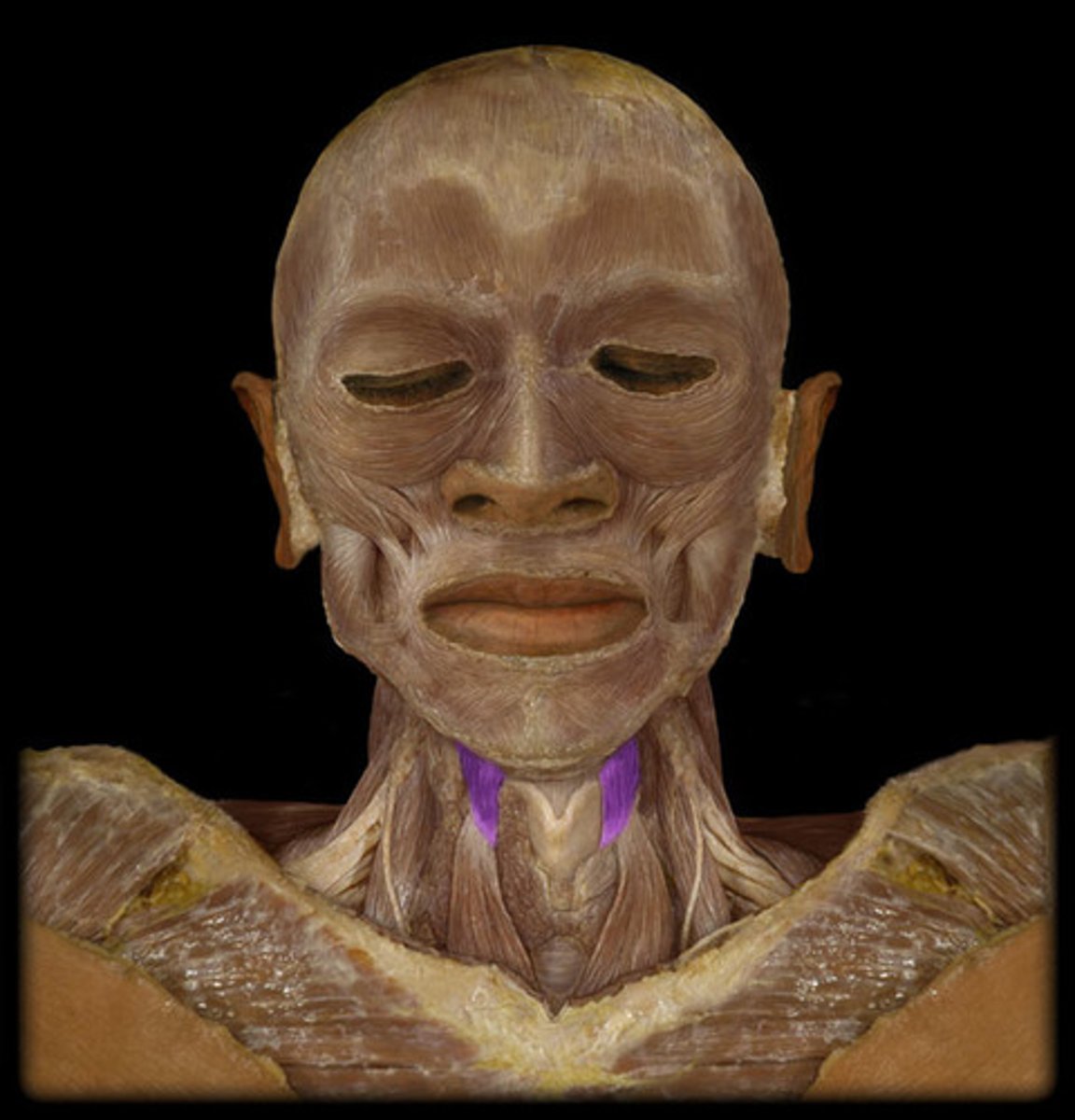Appendicular Muscles APR, Axial Muscles APR
1/65
There's no tags or description
Looks like no tags are added yet.
Name | Mastery | Learn | Test | Matching | Spaced |
|---|
No study sessions yet.
66 Terms
Pectoralis minor
Origin: Ribs 3-5 and overlying fascia
Insertion: Coracoid process of scapula
Action: With serratus anterior, draws scapula laterally and forward around chest wall; with other muscles, rotates scapula and depresses apex of shoulder
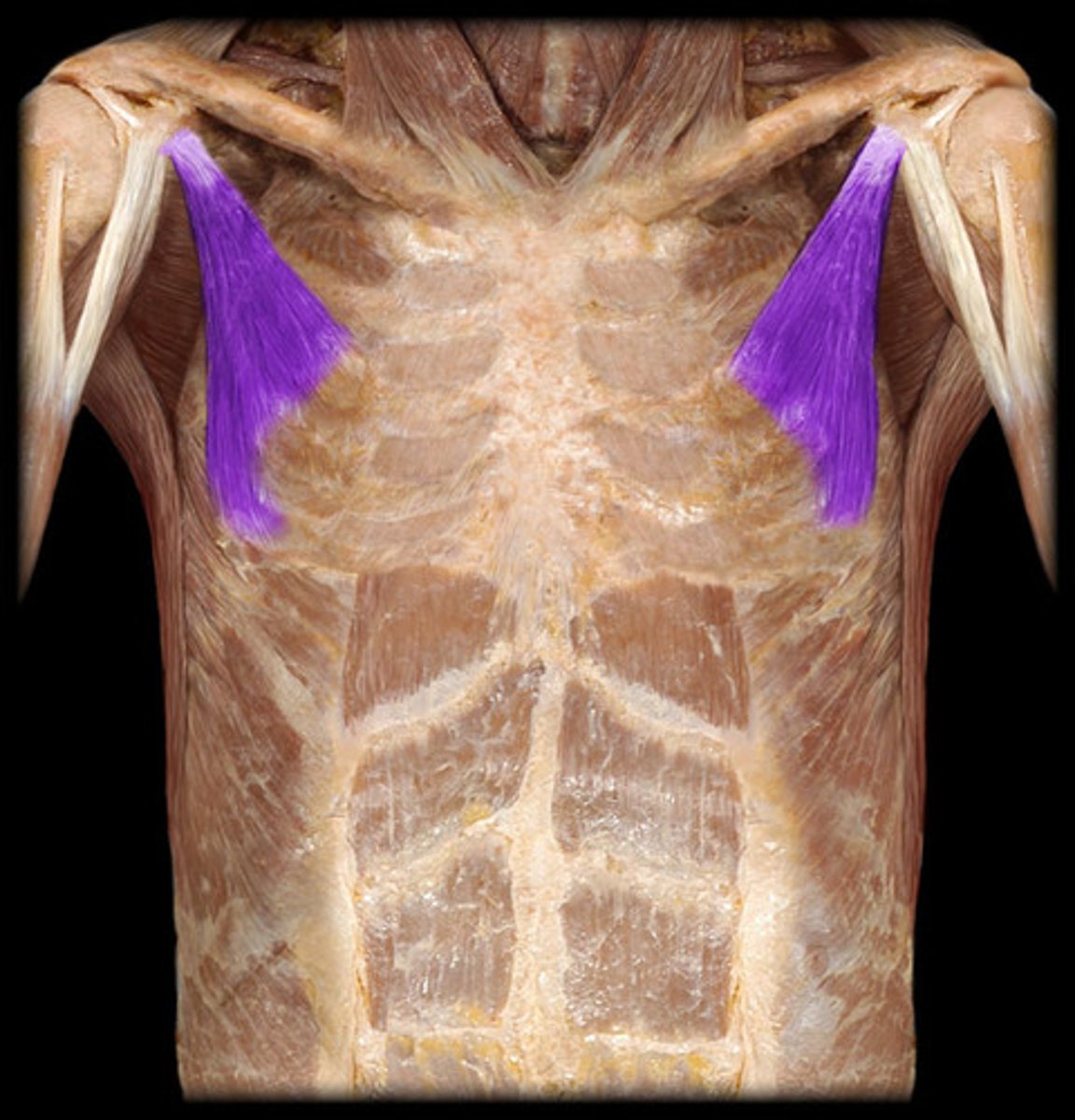
Serratus anterior
Origin: All or nearby all ribs
Insertion: Medial border of scapula
Action: With pectoralis minor, draws scapula laterally and forward around chest wall; protracts scapula, and is the prime mover in all forward-reaching and pushing actions; fixes scapula during abduction of arm
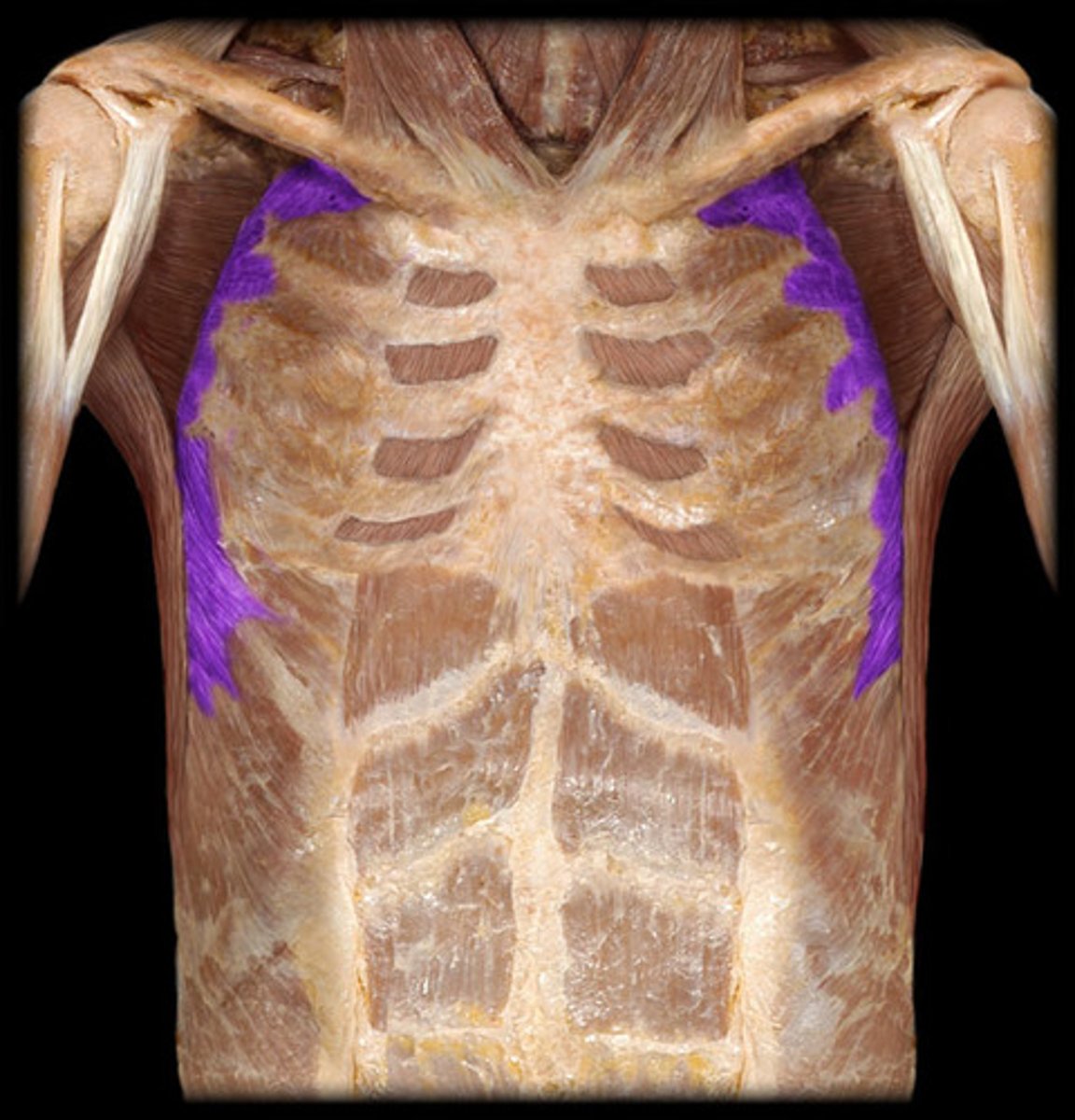
Trapezius
Origin: External occipital protuberance; medial one-third of superior nuchal line; nuchal ligament; spinous processes of vertebrae T1-T12
Insertion: Acromion and spine of scapula; lateral one-third of clavicle
Action: Stabilizes scapula and shoulder during arm movements; elevates and depresses shoulder; rotates and retracts scapula
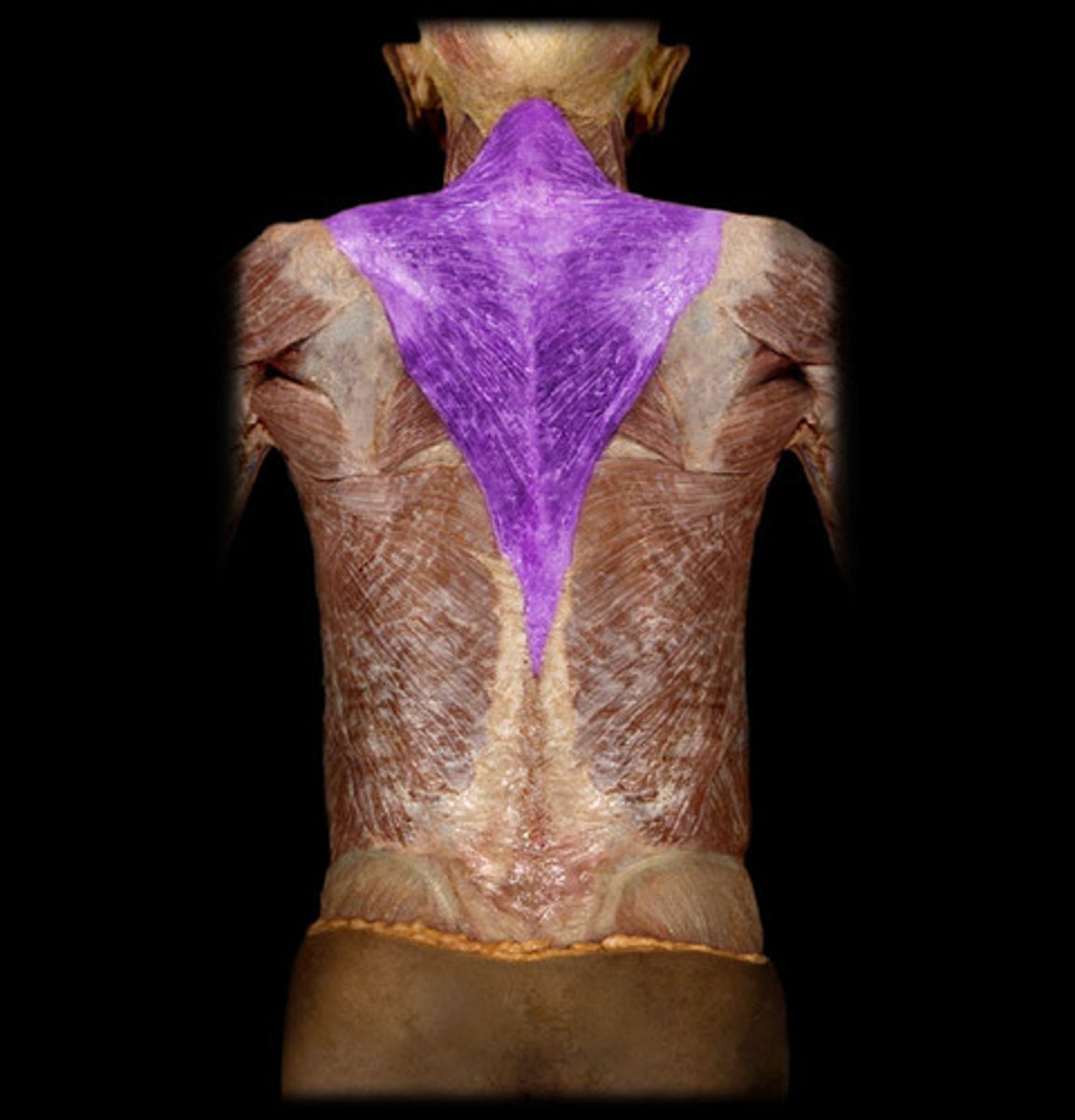
Levator scapulae
Origin: Transverse processes of vertebrae C1-C4
Insertion: Superior angle to medial border of scapula
Action: Elevates scapula if cervical vertebrae are fixed; flexes neck laterally if scapula is fixed; retracts and braces shoulder
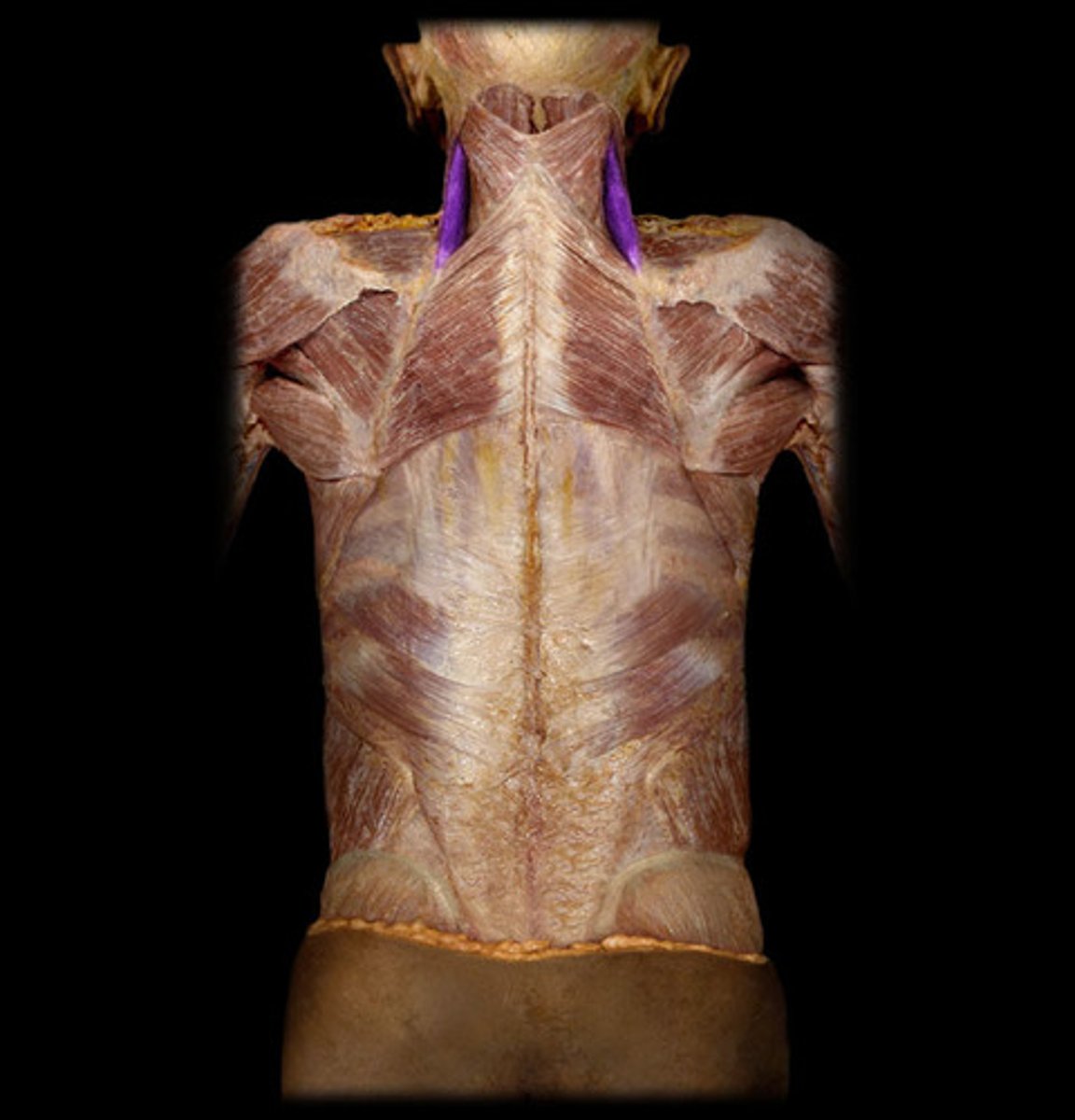
Rhomboideus major
Origin: Spinous processes of vertebrae C7-T1; nuchal ligament
Insertion: Medial border of scapula
Action: Retracts scapula and braces shoulder; fixes scapula during arm movements
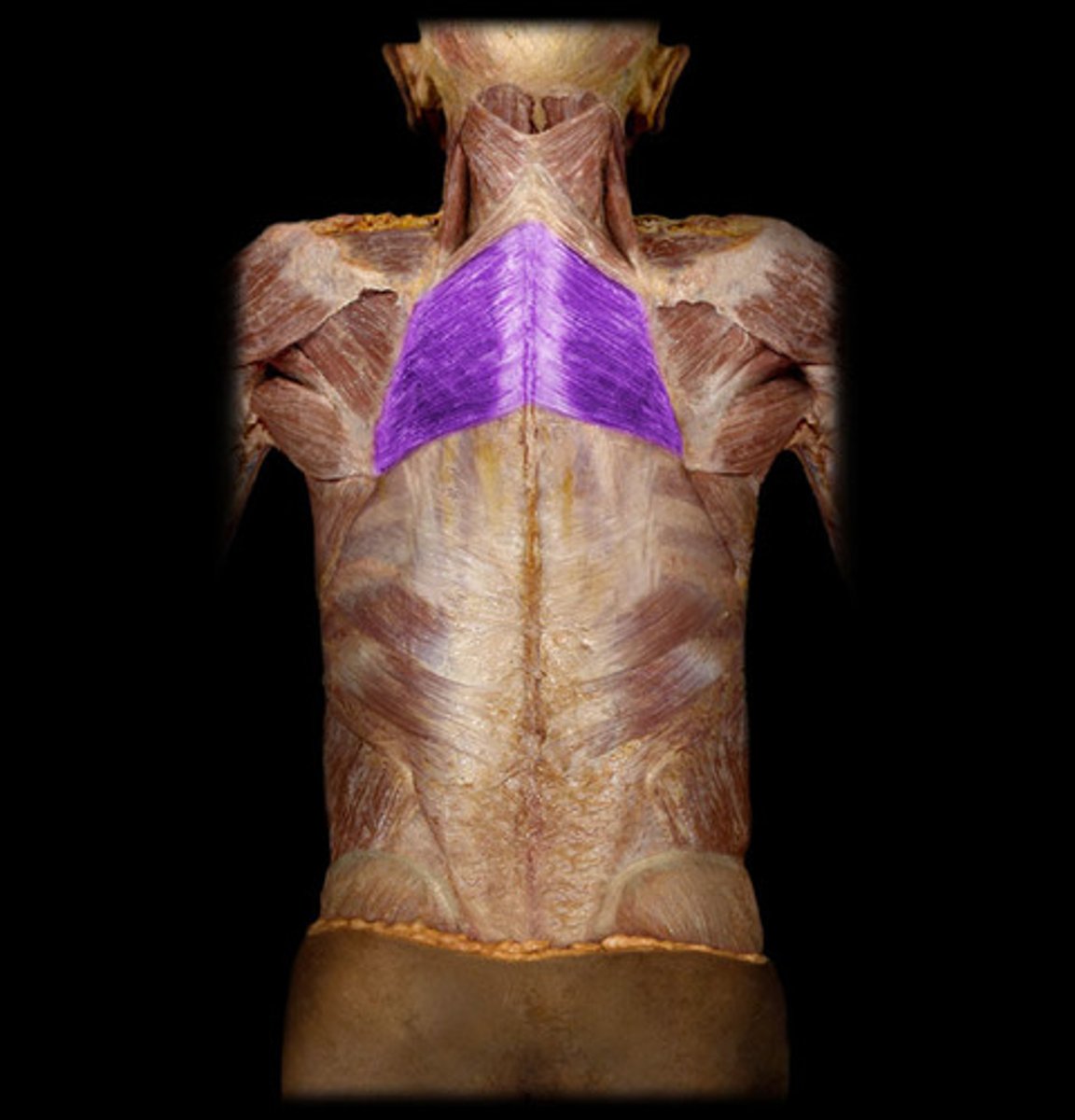
Rhomboideus minor
Origin: Spinous processes of vertebrae C7-T1; nuchal ligament
Insertion: Medial border of scapula
Action: Retracts scapula and braces shoulder; fixes scapula during arm movements
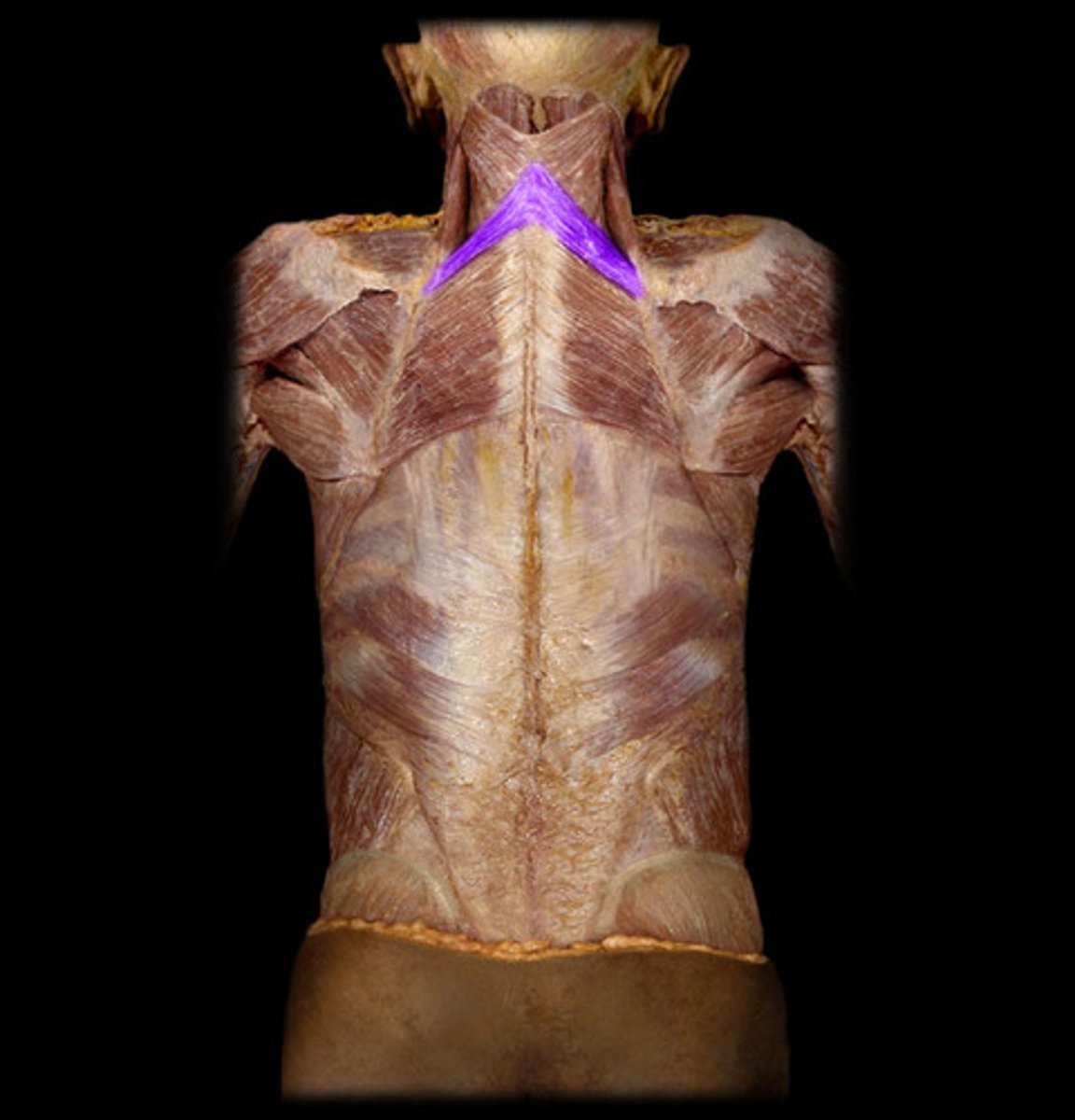
Latissimus dorsi
Origin: Vertebrae T7-L5; lower three or four ribs; illiac crest; thoracolumbar fascia
Insertion: Intertubercular sulcus of humerus
Action: Adducts and medially rotates humerus; helps move arm posteriorly
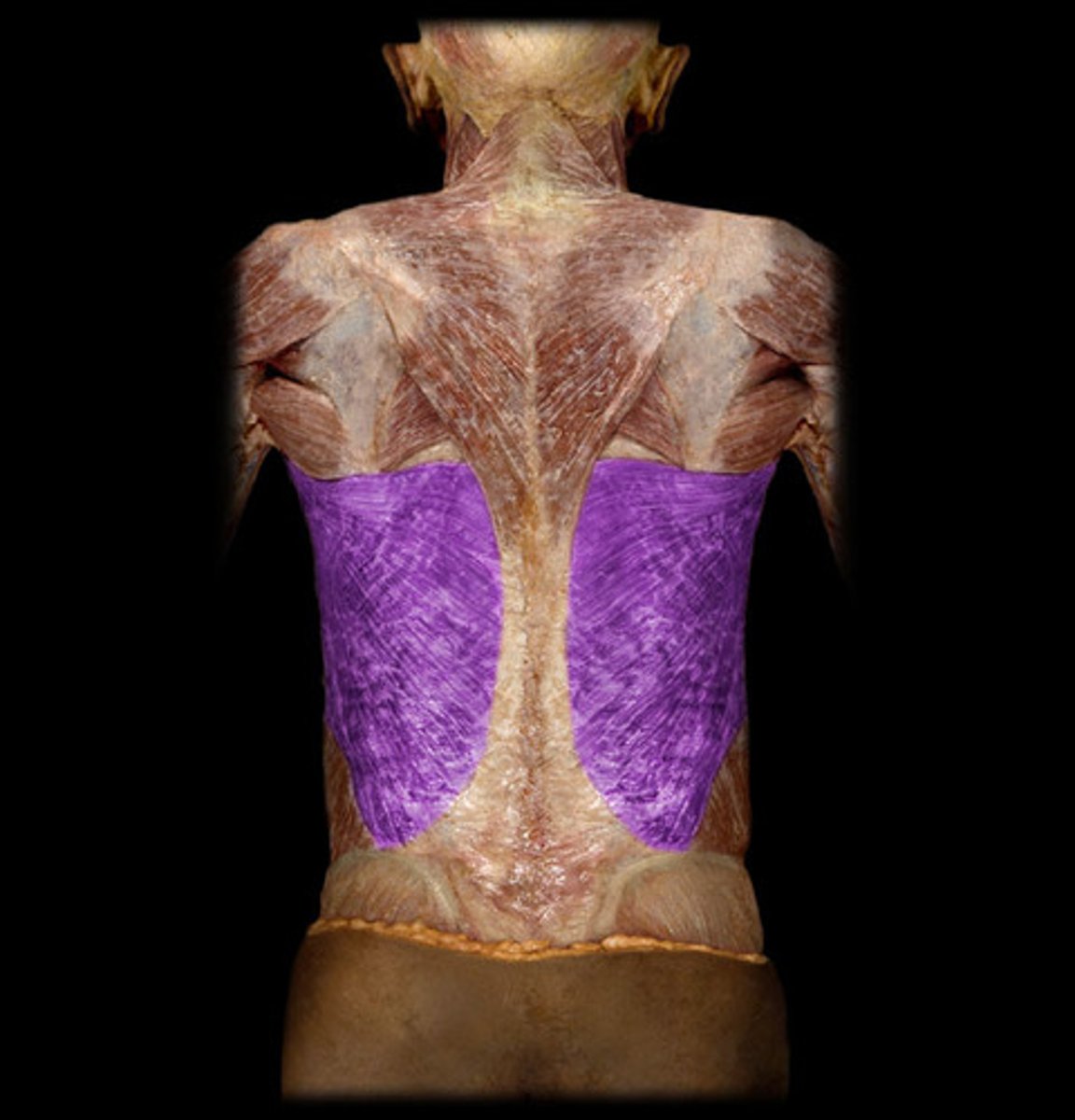
Pectoralis major
Origin: Medial half of clavicle; lateral margin of sternum; costal cartilages 1-7; aponeurosis of external oblique
Insertion: Intertubercular sulcus of humerus
Action: Flexes, adducts, and medially rotates humerus

Deltoid
Origin: Acromion and spine of scapula; lateral portion of clavicle
Insertion: Deltoid tuberosity of humerus
Action: Anterior fibers flex and medially rotate arm; lateral fibers abduct arm; posterior fibers extend and laterally rotate arm
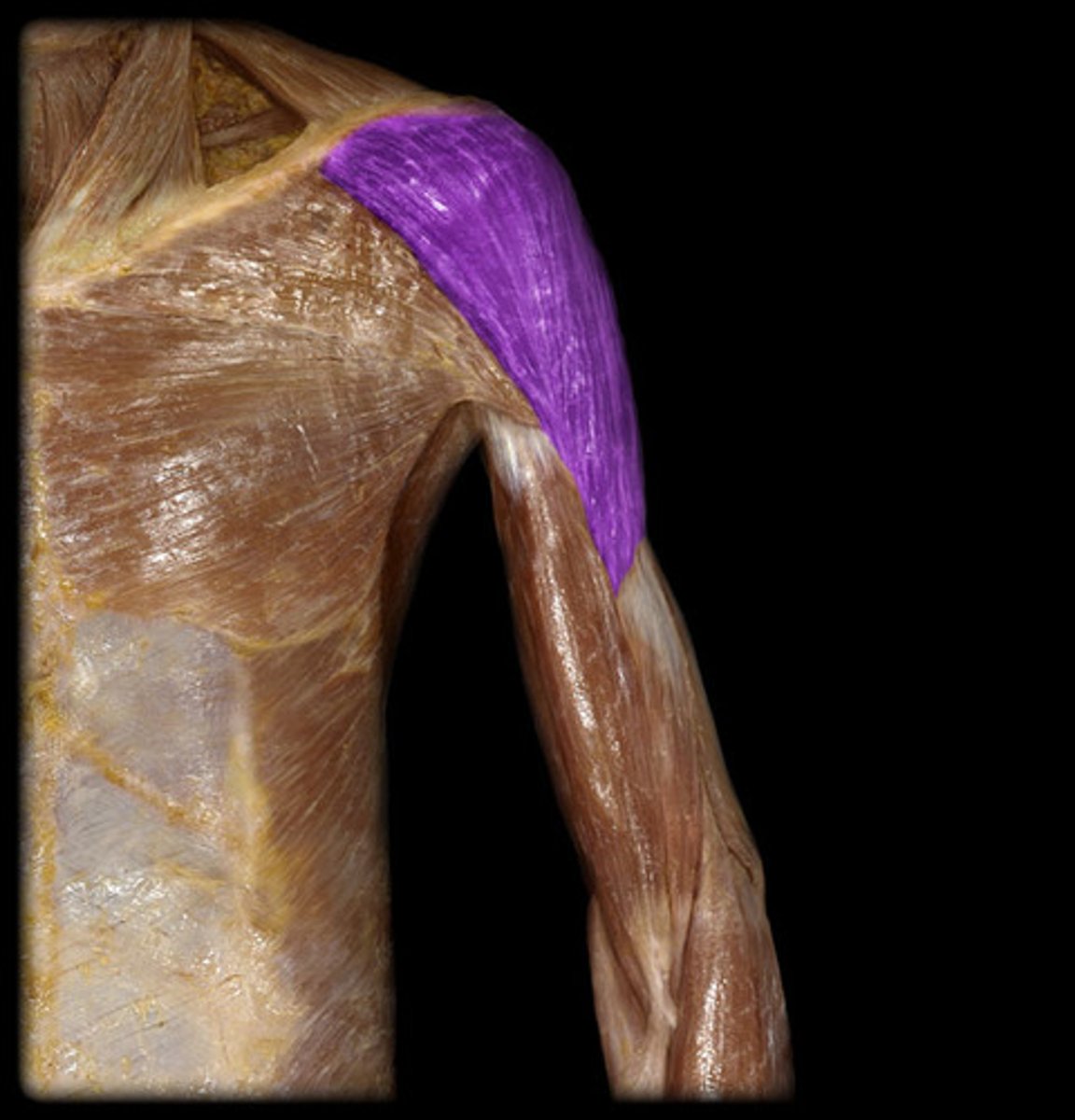
Coracobrachialis
Origin: Coracoid process
Insertion: Medial aspect of humeral shaft
Action: Flexes and medially rotates arm
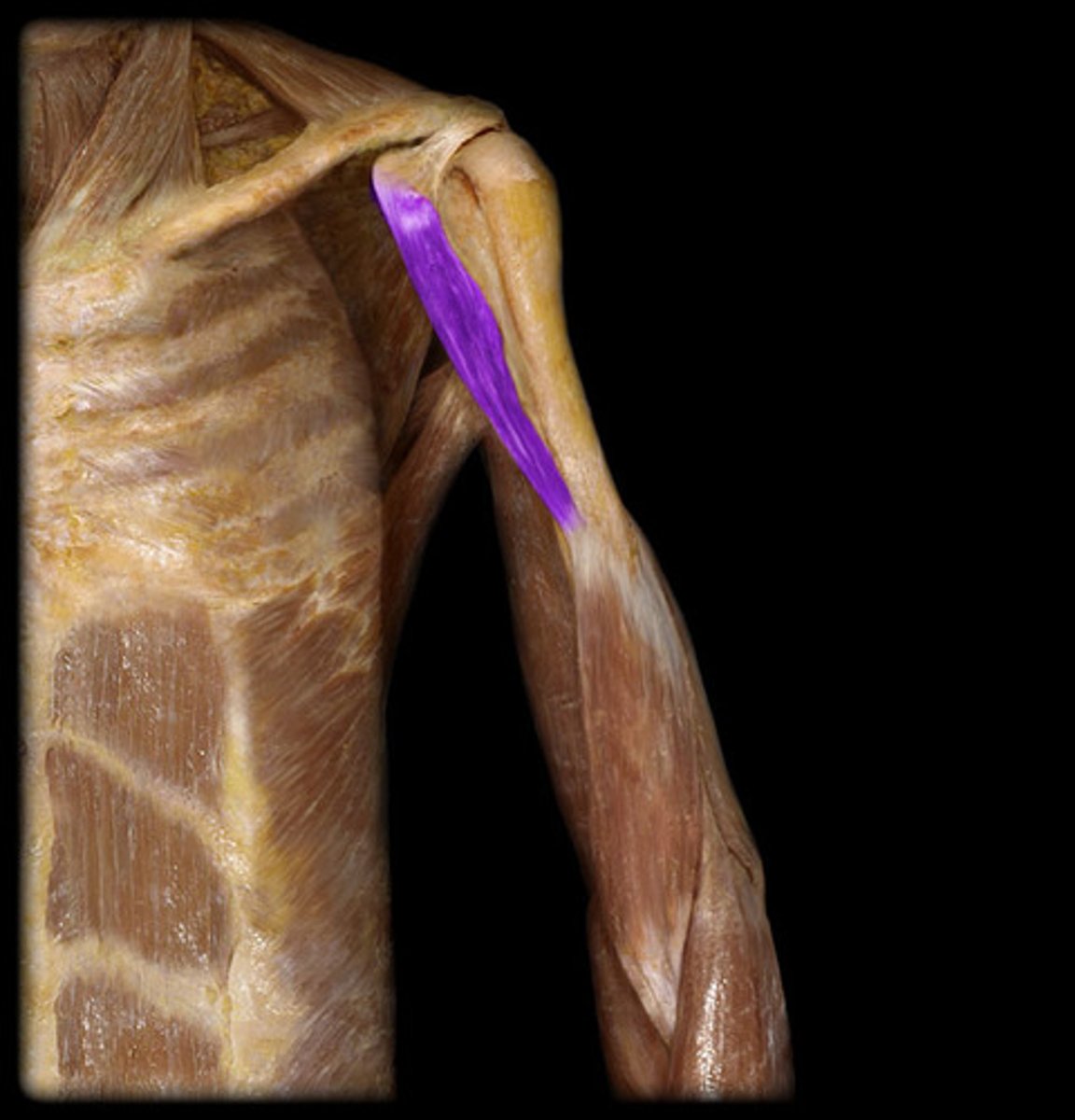
Teres major
Origin: Inferior angle of scapula
Insertion: Intertubercular sulcus of humerus
Action: Extends and medially rotates humerus
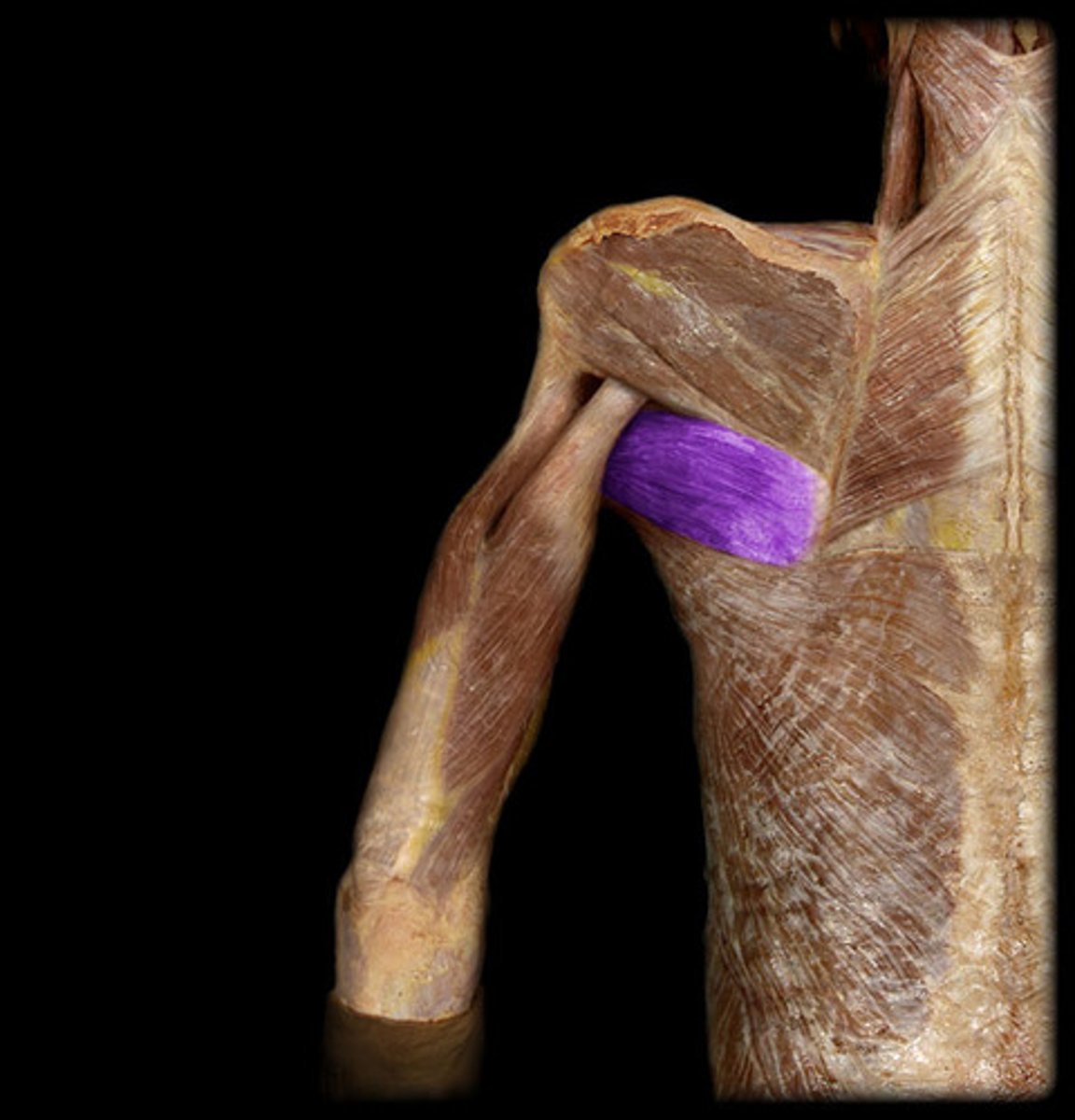
Subscapularis
Origin: Subscapular fossa of scapula
Insertion: Lesser tubercle of humerus; anterior surface of joint capsule
Action: Modulates action of deltoid, preventing humeral head from sliding upward when arm is abducted; rotates humerus medially
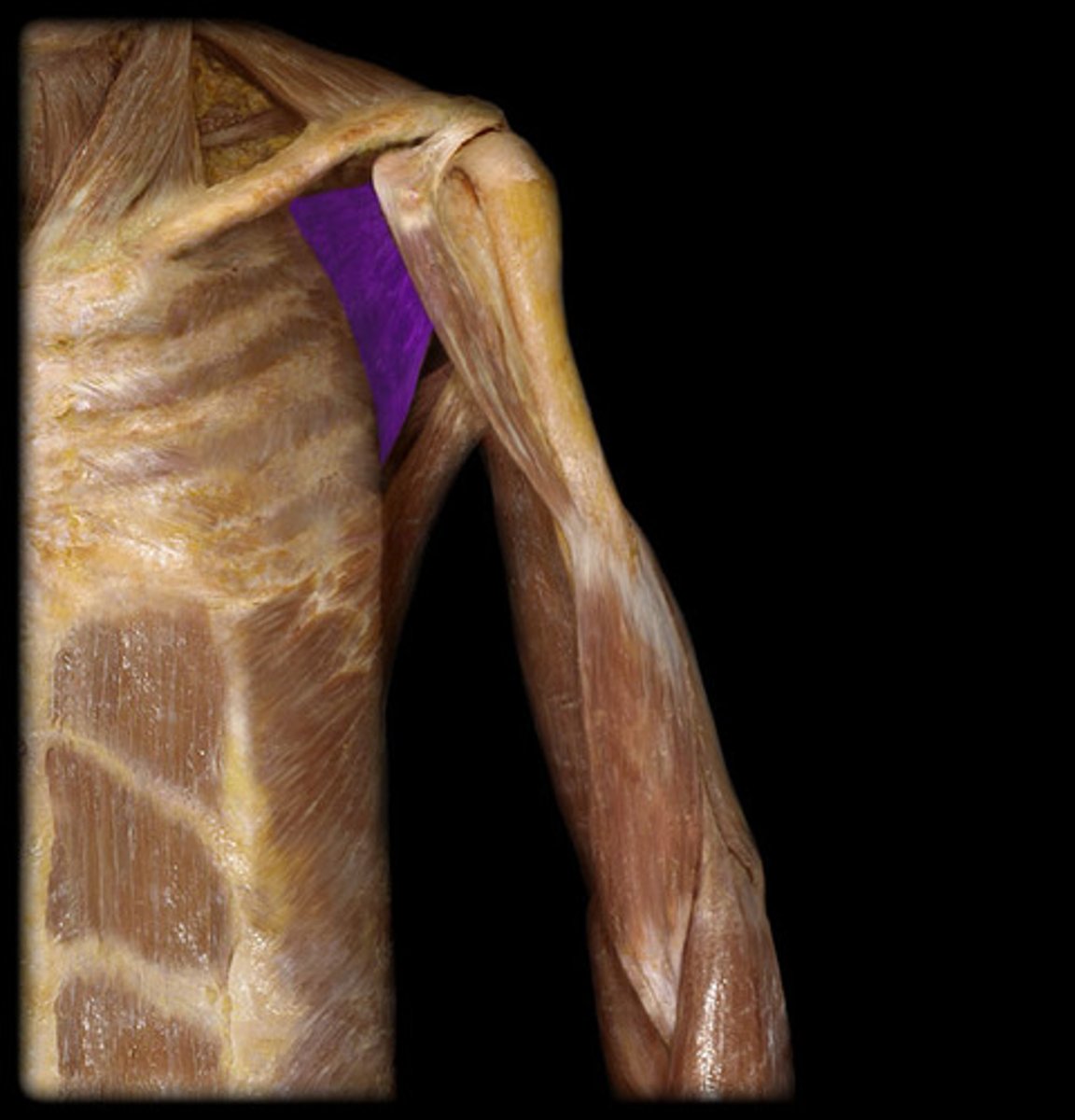
Supraspinatus
Origin: Supraspinous fossa of scapula
Insertion: Greater tubercle of humerus
Action: Aids deltoid in abduction of arm; supports humeral head when carrying weight
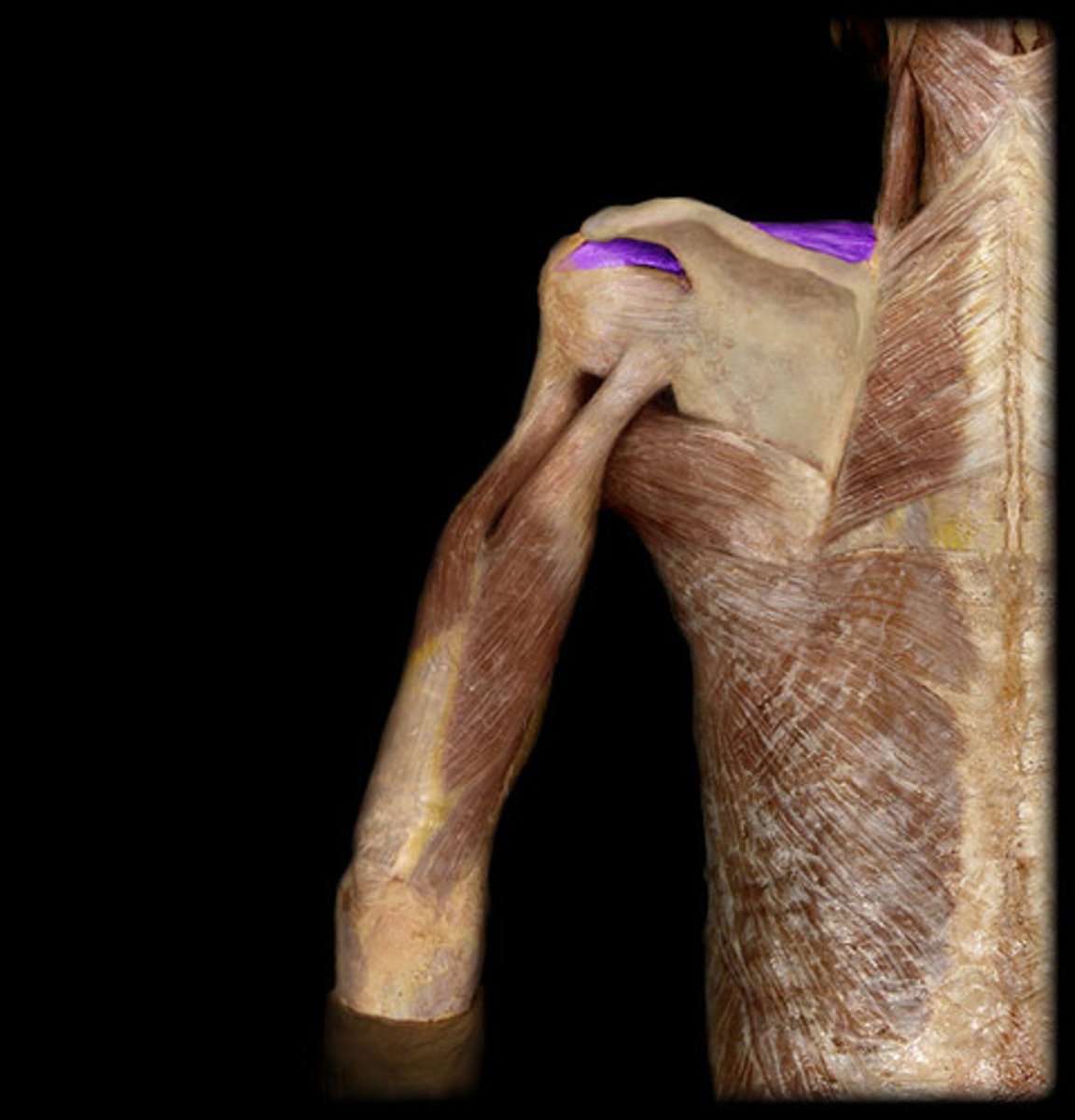
Infraspinatus
Origin: Infraspinous fossa of scapula
Insertion: Greater tubercle of humerus
Action: Modulates action of deltoid, preventing humeral head from sliding upward; rotates humerus laterally
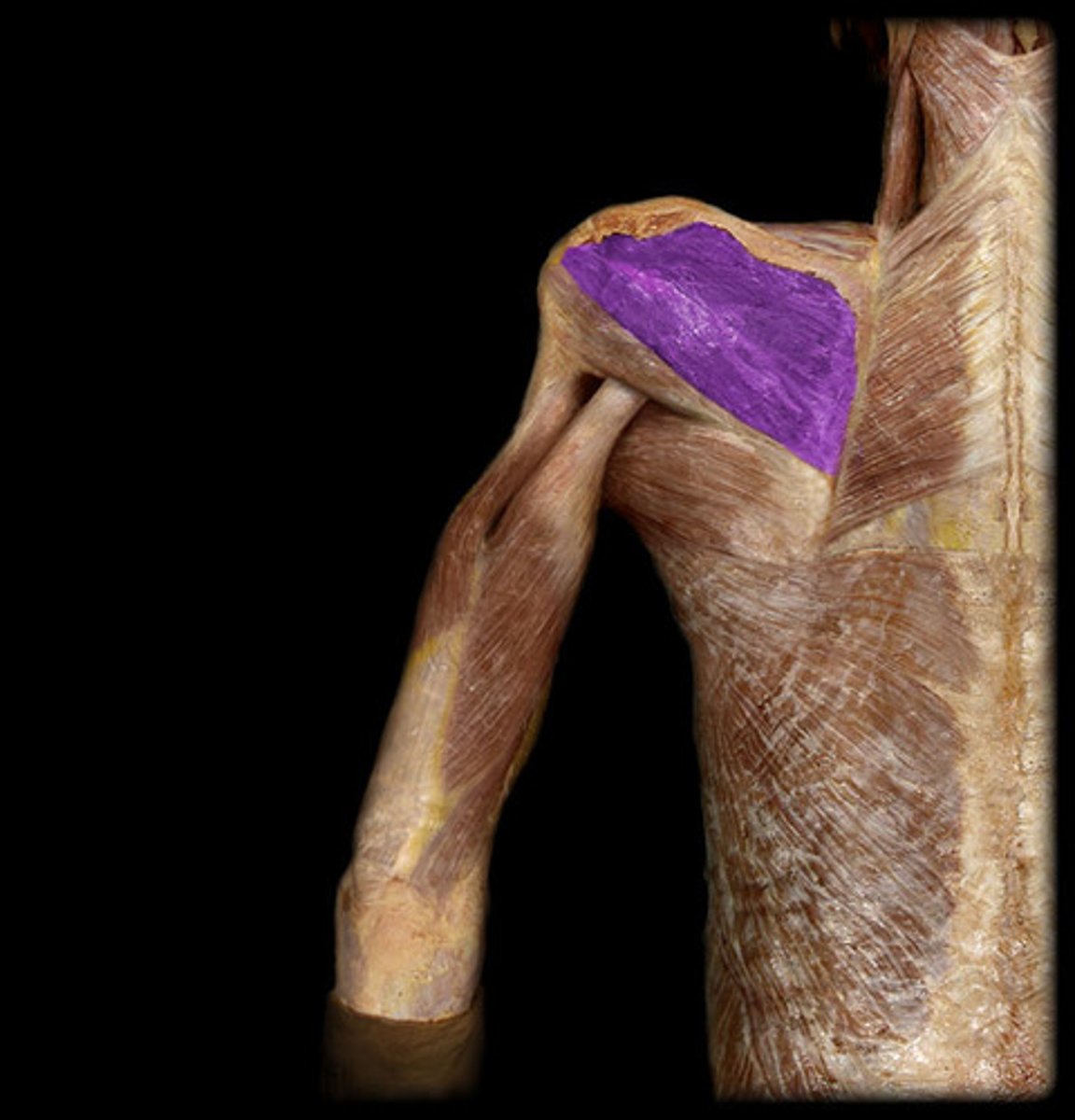
Teres minor
Origin: Lateral border and adjacent posterior surface of scapula
Insertion: Greater tubercle of humerus; posterior surface of joint capsule
Action: Modulates action of deltoid, preventing humeral head from sliding upward as arm is abducted; rotates humerus laterally

Biceps brachii
Origins:
Long Head: Superior margin of glenoid cavity
Short Head: Coracoid process of scapula
Insertion: Tuberosity of radius; fascia of forearm
Action: Synergist of elbow flexion; rapid or forceful supination of forearm; tendon of long head helps support glenohumeral joint

Brachialis
Origin: Anterior surface of distal half of humerus
Insertion: Coronoid process and tuberosity of ulna
Action: Prime mover of elbow flexion

Brachioradialis
Origin: Lateral supracondylar ridge of humerus
*Insertion: Lateral surface of radius near styloid process
Action: Flexes elbow

Triceps brachii
Origins:
Long Head: inferior margin of glenoid cavity and joint capsule
Lateral Head: posterior surface of proximal end of humerus
Medial Head: posterior surface of distal end of humerus
Insertion: Olecranon; fascia of forearm
Action: Prime mover of elbow extension, long head extends and adducts humerus
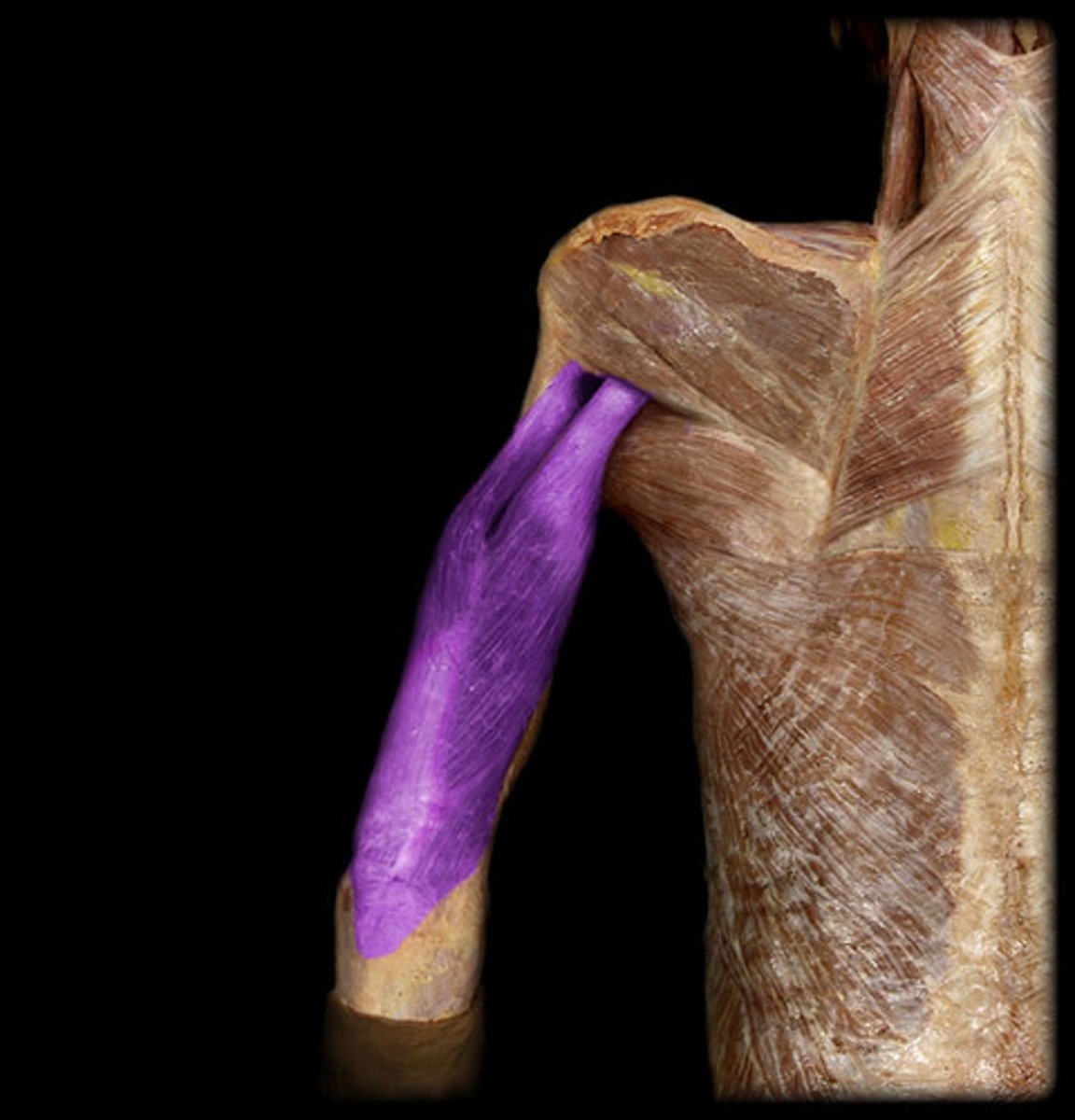
Pronator quadratus
Origin: Anterior surface of distal ulna
Insertion: Anterior surface of distal radius
Action: Prime mover of forearm pronation; also resists separation of radius and ulna when force is applied to forearm through wrist
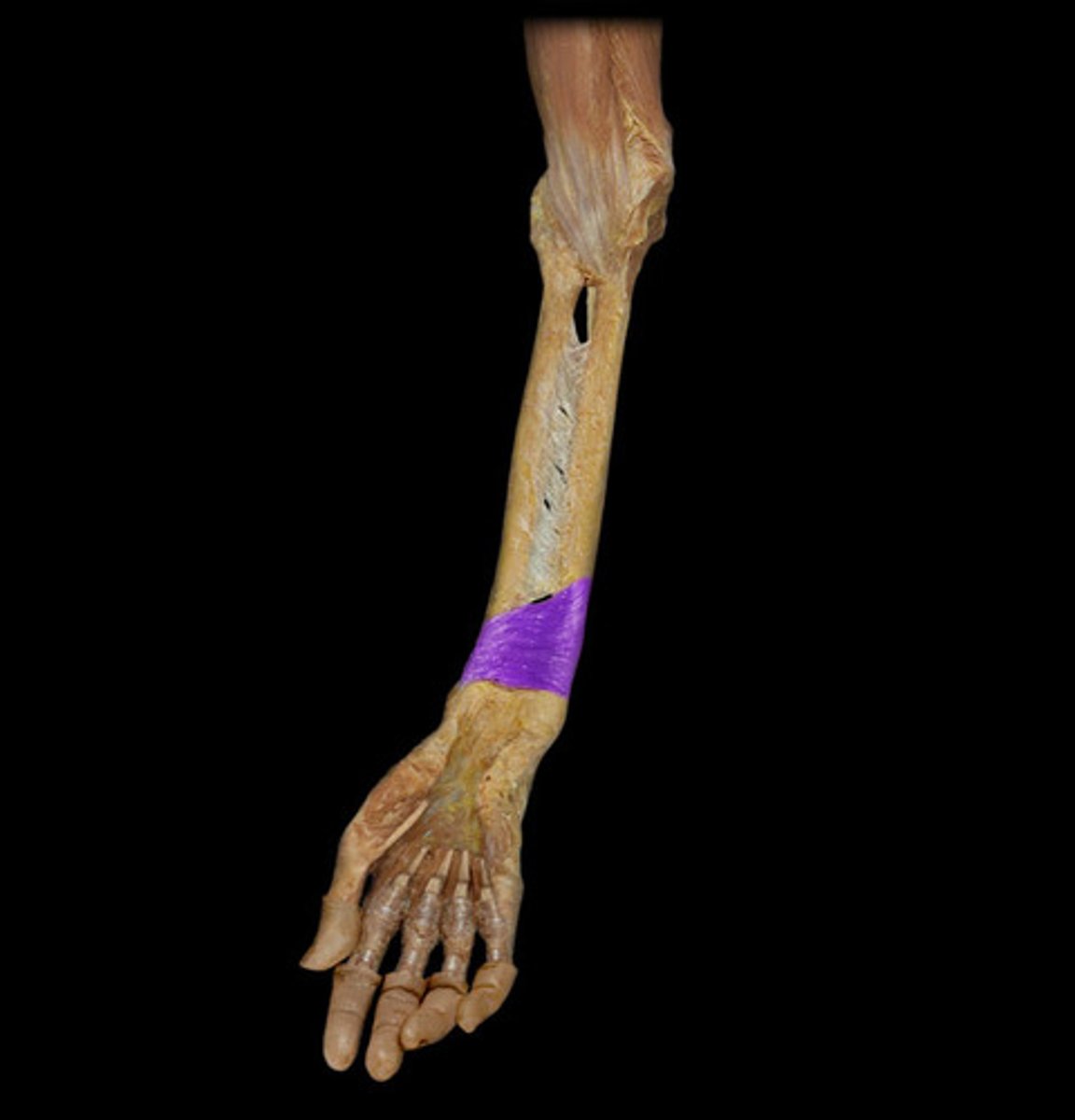
Pronator teres
Origin: Humeral shaft near medial epicondyle; coronoid process of ulna
Insertion: Lateral surface of radial shaft
Action: Assists pronator quadratus in pronation, but only in rapid or forceful action; weakly flexes elbow

Supinator
Origin: Lateral epicondyle of humerus
Insertion: Proximal one-third of radius
Action: Supinates forearm

Psoas major
Origin: Body of T12 and L1-5 vertebrae
Insertion: lesser trochanter of femur
Action: Flexion of thigh (hip); lateral rotation of thigh; lateral flexion of trunk
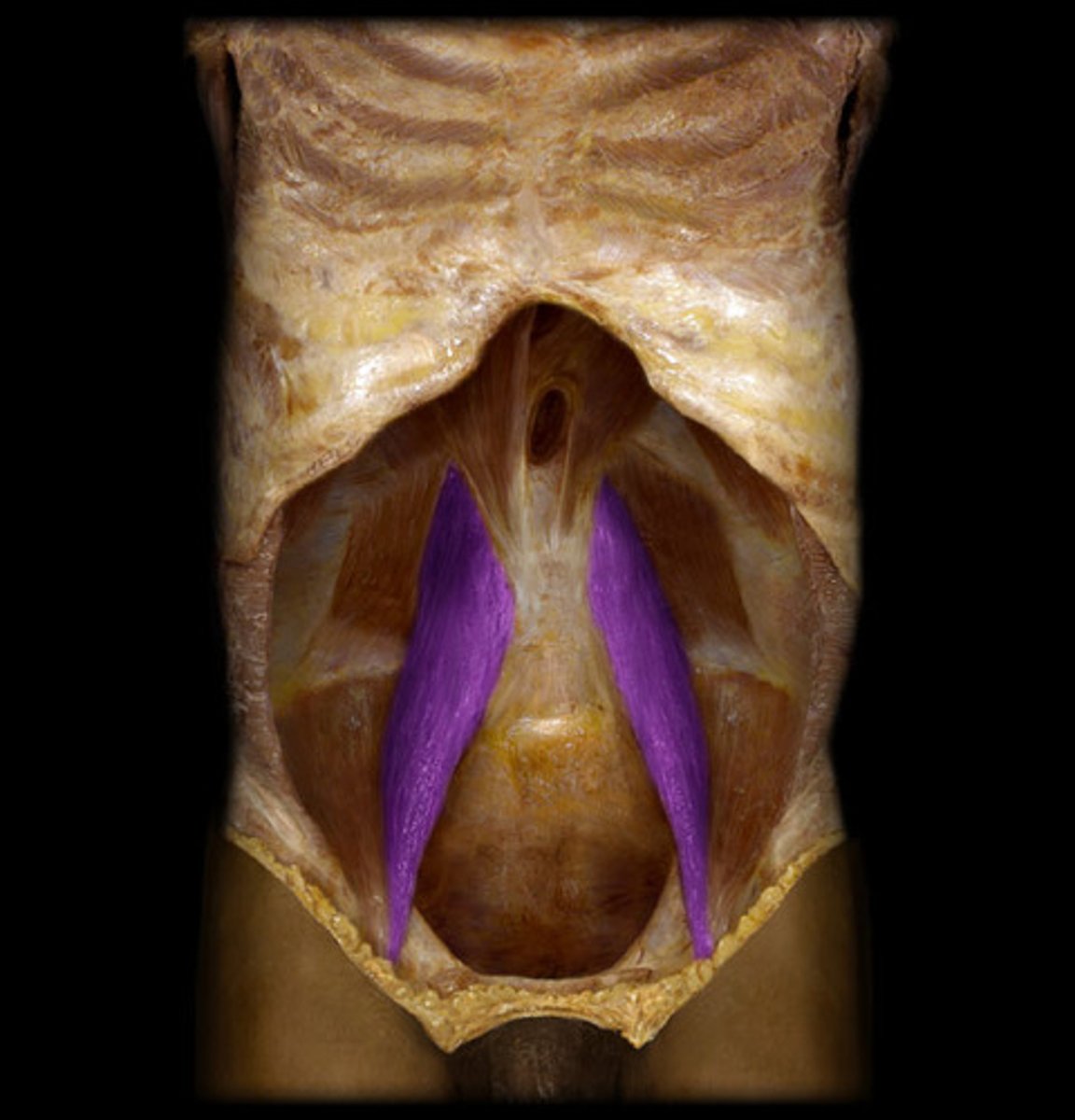
Sartorius
Origin: Anterior superior iliac spine
Insertion: Medial surface of proximal end of tibia
Action: Aids in knee and hip flexion; abducts and laterally rotates thigh
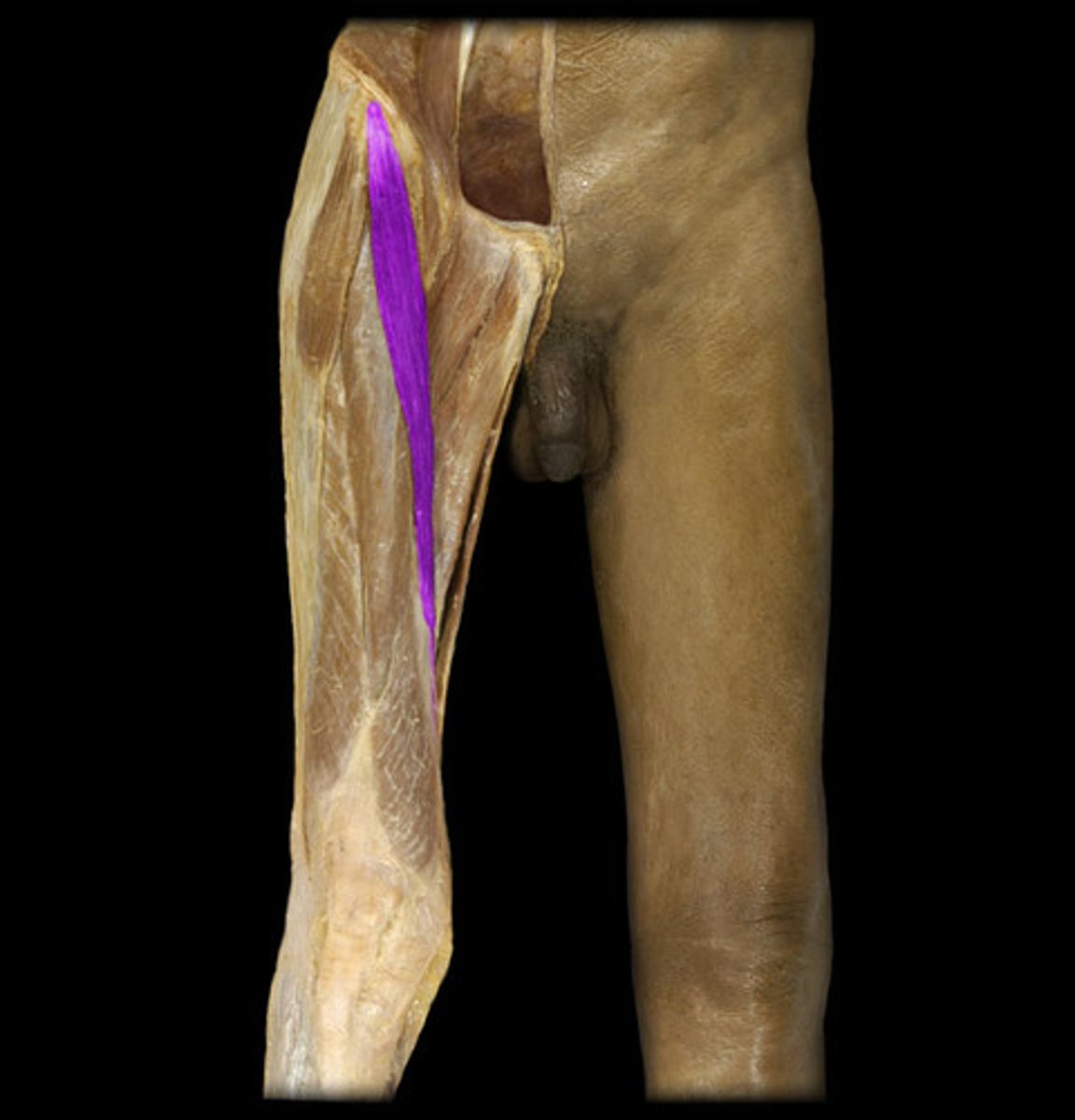
Rectus femoris
Origin: Ilium at anterior inferior spine and superior margin of acetabulum; capsule of hip joint
Insertion: Patella; tibial tuberosity; lateral and medial condyles of tibia
Action: Extends knee, flexes thigh at hip

Adductor longus
Origin: Body and inferior ramus of pubis
Insertion: Linea aspera of femur
Action: Adducts and medially rotates thigh; flexes thigh at hip
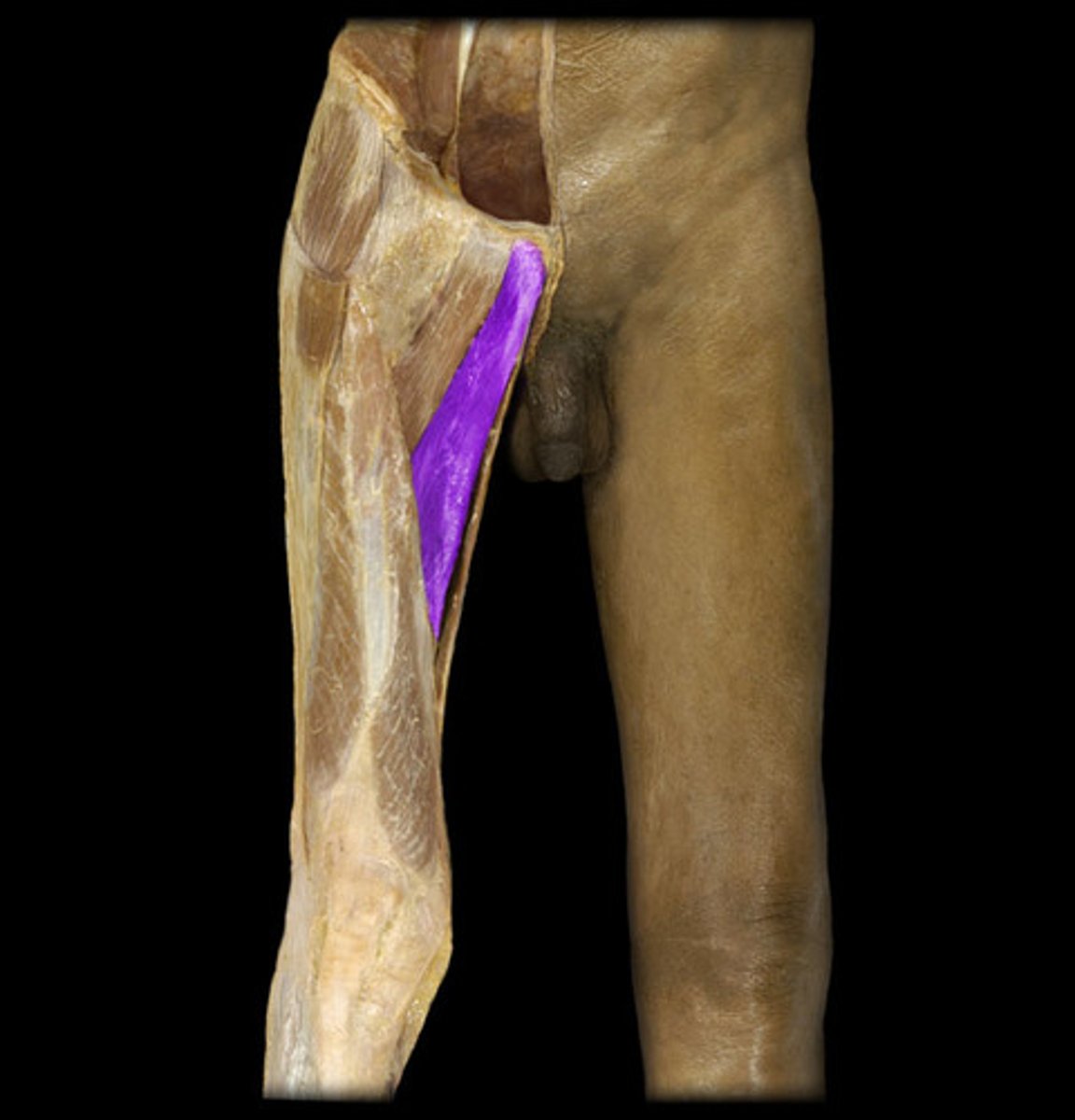
Adductor brevis
Origin: Body and inferior ramus of pubis
Insertion: Linea aspera and spiral line of femur
Action: Adducts thigh
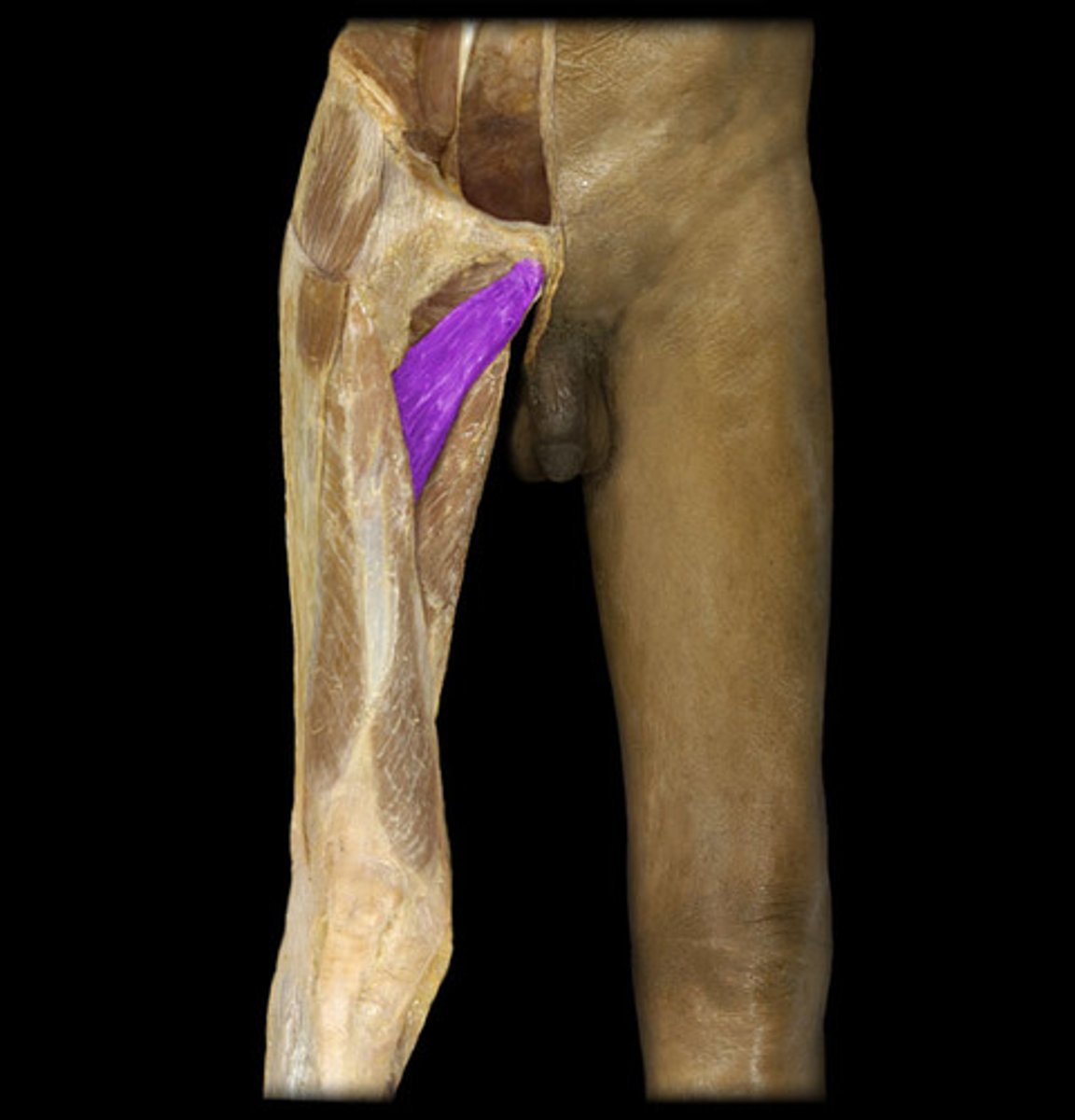
Gracilis
Origin: Body and inferior ramus of pubis; ramus of ischium
Insertion: Medial surface of tibia just below condyle
Action: Flexes and medially rotates tibia at knee
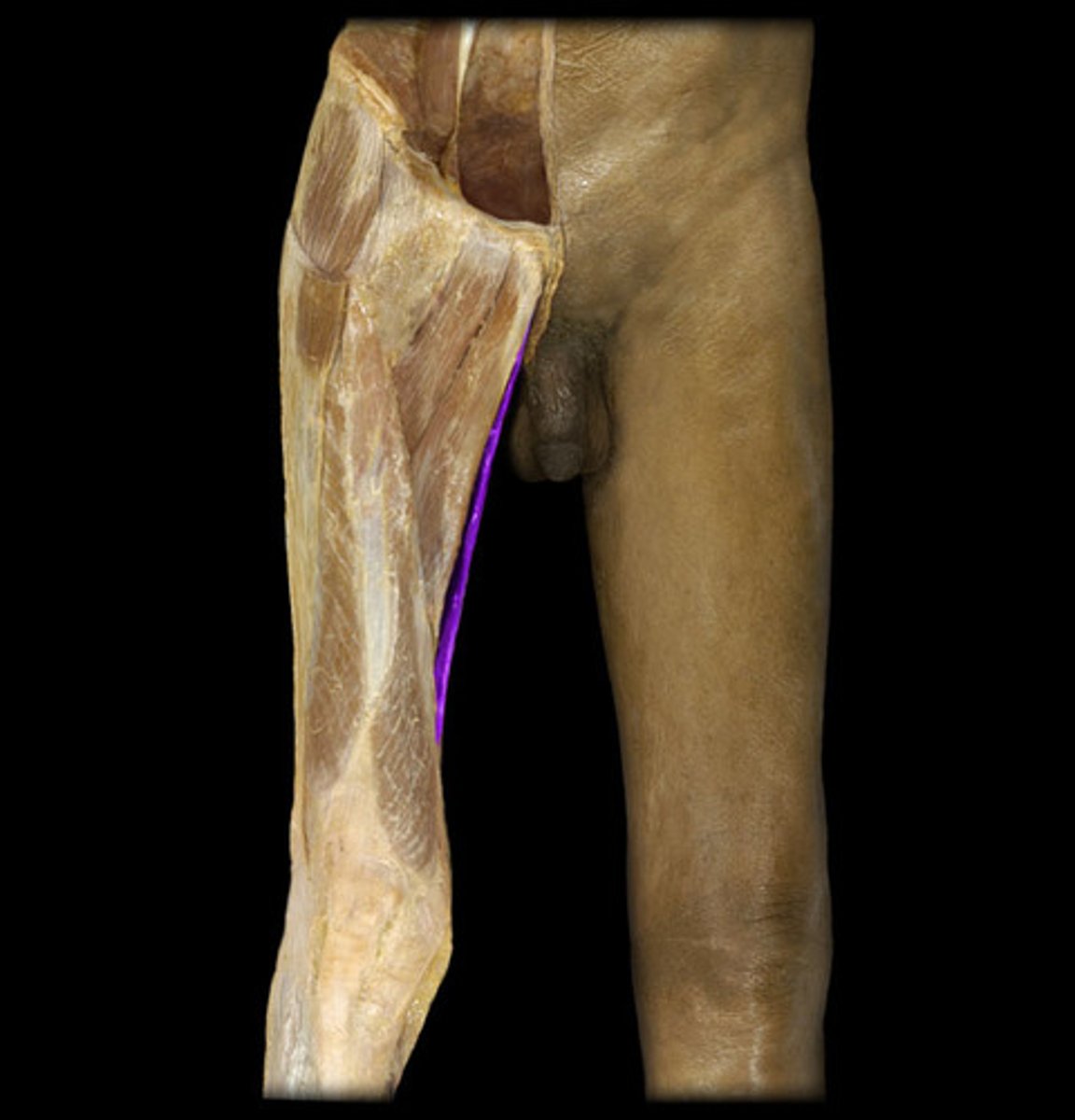
Pectineus
Origin: Pectineal line of pubis
Insertion: Spiral line of femur
Action: Flexes and adducts thigh
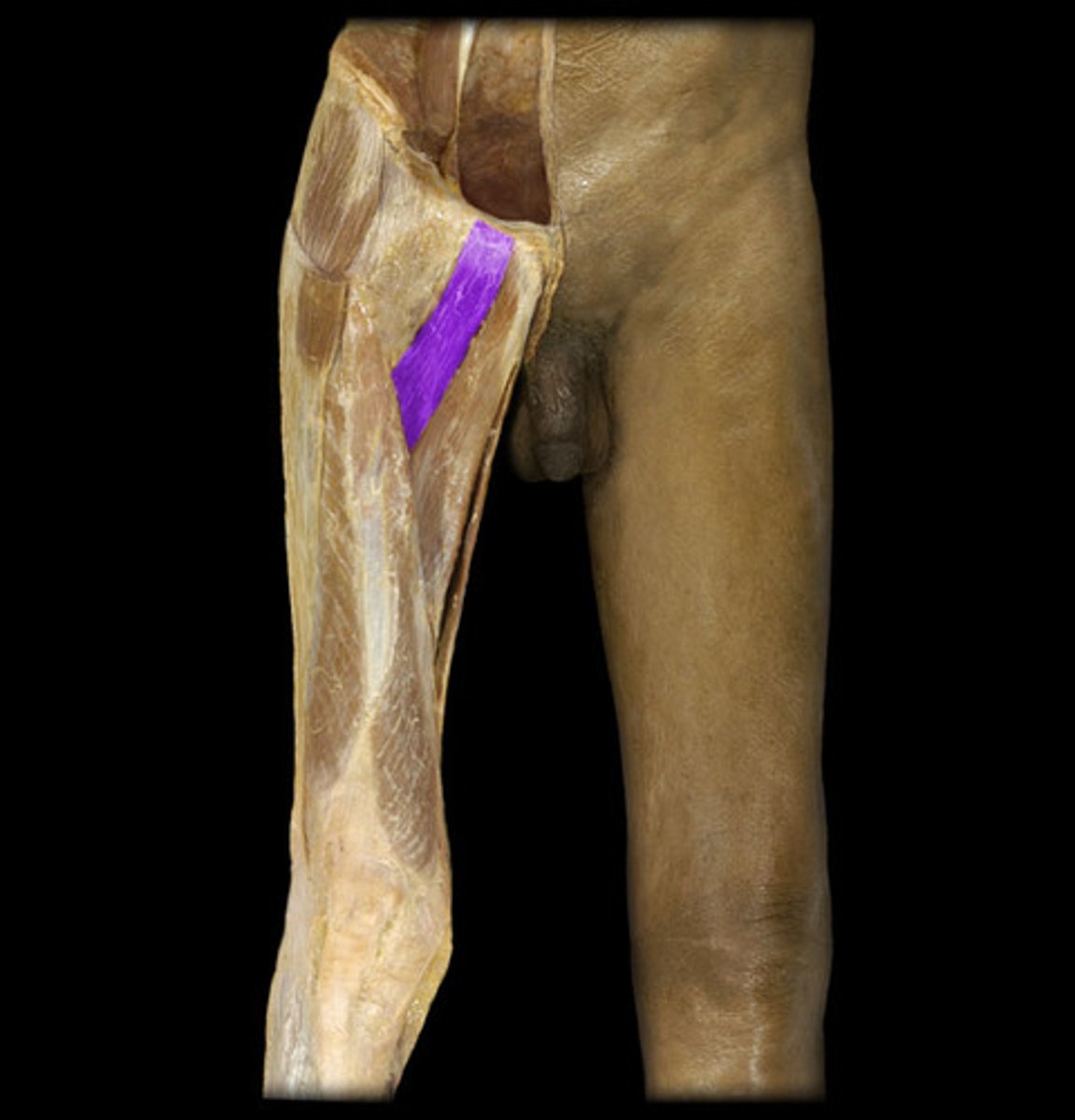
Adductor magnus
Origin: Inferior ramus of pubis; ramus and tuberosity of ischium
Insertion: Linea aspera, gluteal tuberosity, and medial supracondylar line of femur
Action: Adducts and medially rotates thigh; extends thigh at hip

Gluteus maximus
Origin: Posterior gluteal line of ilium; coccyx; posterior surface of lower sacrum; aponeurosis of erector spinae
Insertion: Gluteal tuberosity of femur; iliotibial tract (lateral condyle of tibia)
Action: Extends thigh at hip; abducts thigh; helps stabilize femur on tibia
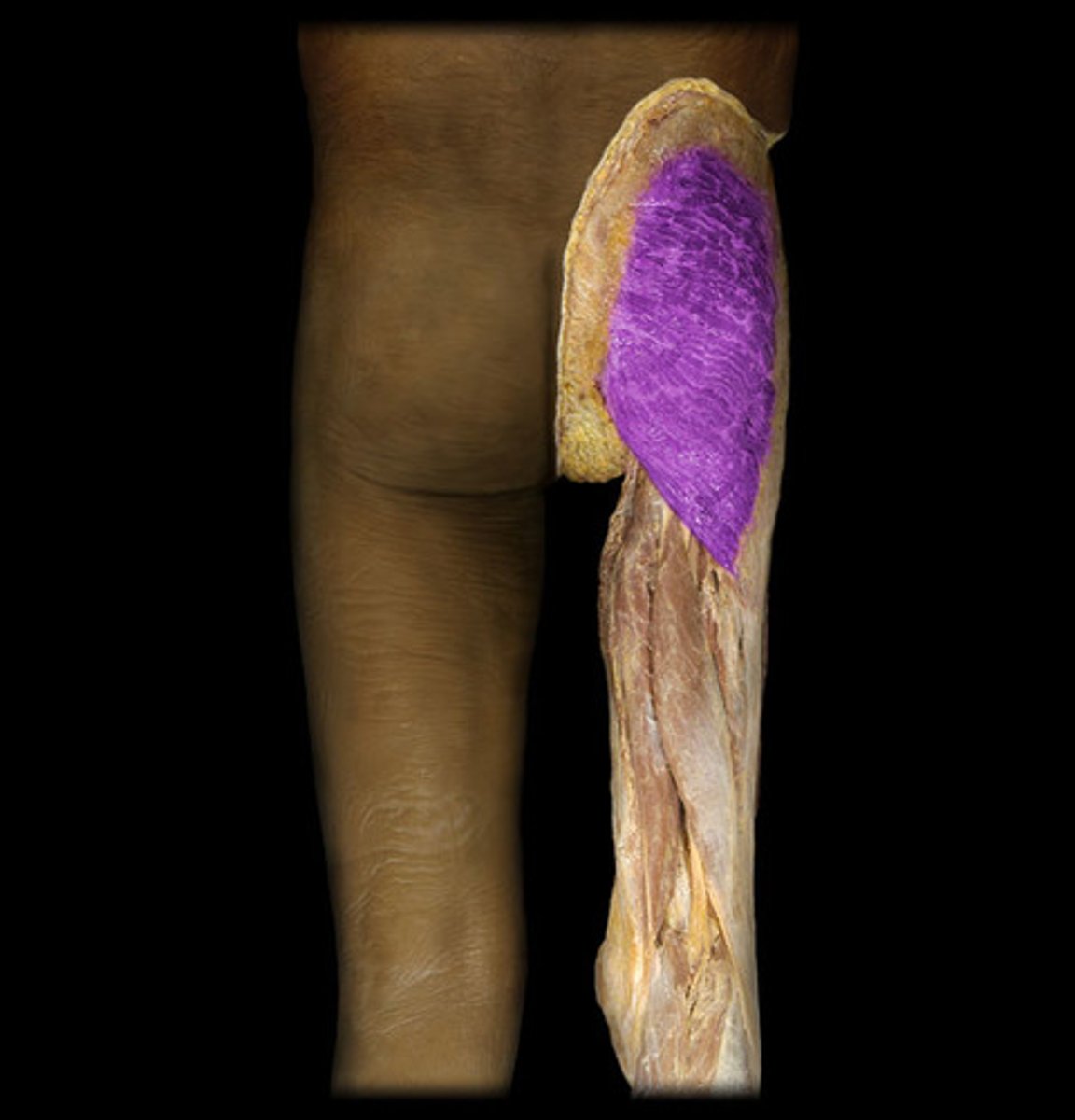
Gluteus medius
Origin: Most of lateral surface of ilium between crest and acetabulum
Insertion: Greater trochanter of femur
Action: Abduct and medially rotate thigh; helps shift weight of trunk
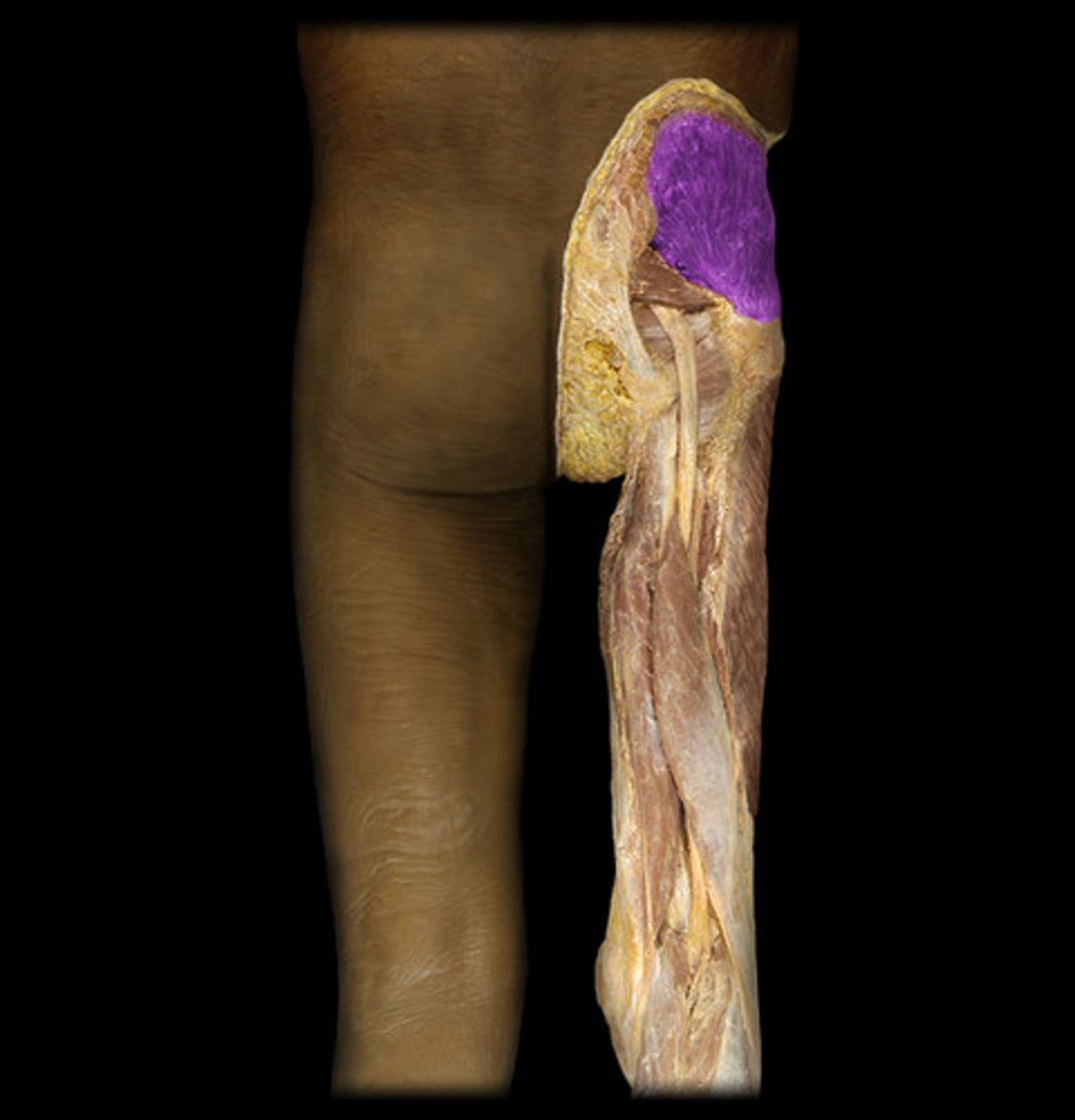
Gluteus minimus
Origin: Most of lateral surface of ilium between crest and acetabulum
Insertion: Greater trochanter of femur
Action: Abduct and medially rotate thigh; helps shift weight of trunk
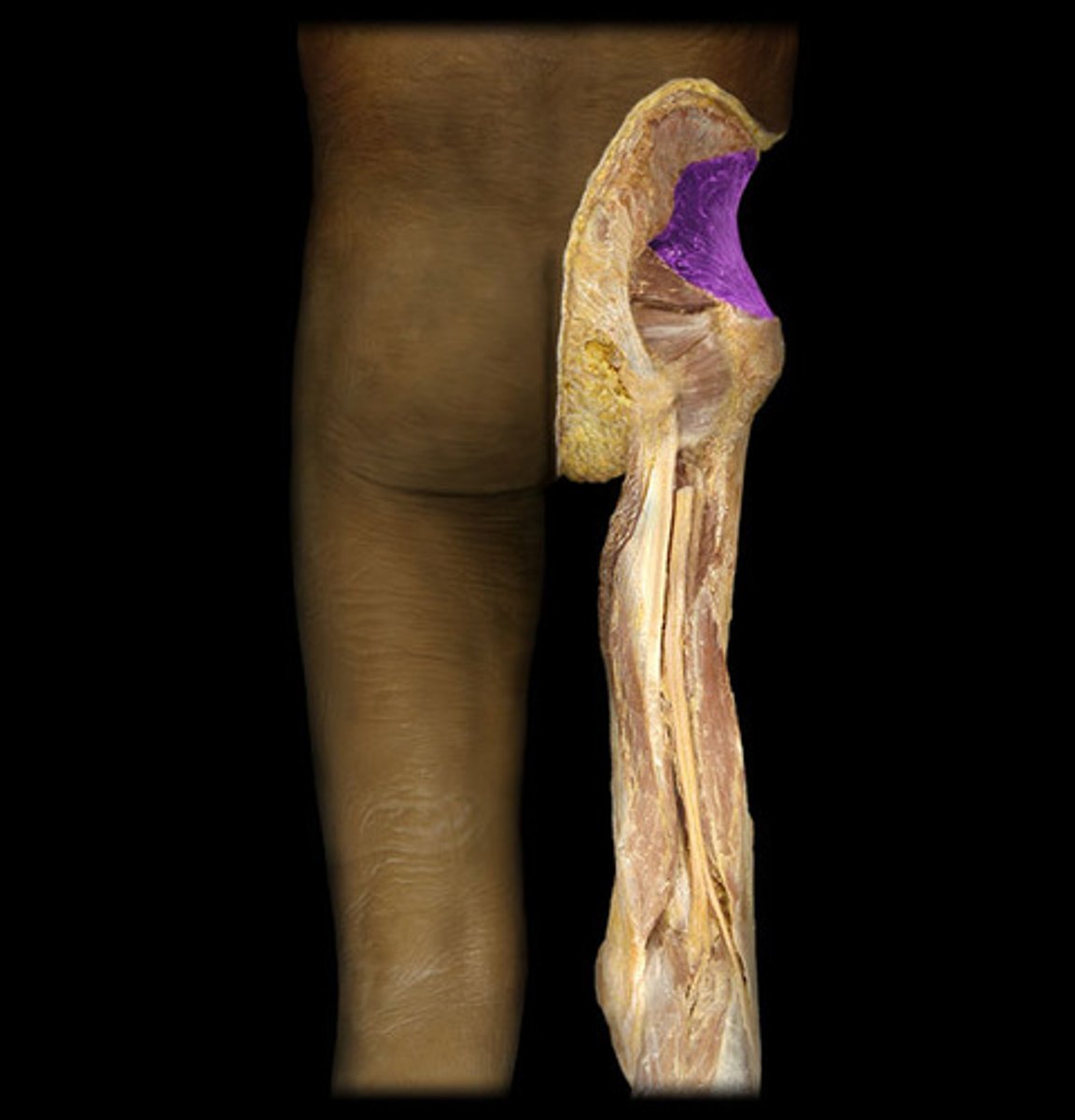
biceps femoris
Origins:
Long Head: ischial tuberosity
Short Head: linea aspera and lateral supracondylar line of femur
Insertion: Head of fibula
Action: Flexes knee; extends hip

Semimembranosus
Origin: Ischial tuberosity
Insertion: Medial condyle and nearby margin of tibia
Action: Flexes knee; medially rotates tibia on femur when tibia is fixed, medially rotates femur when hip is extended
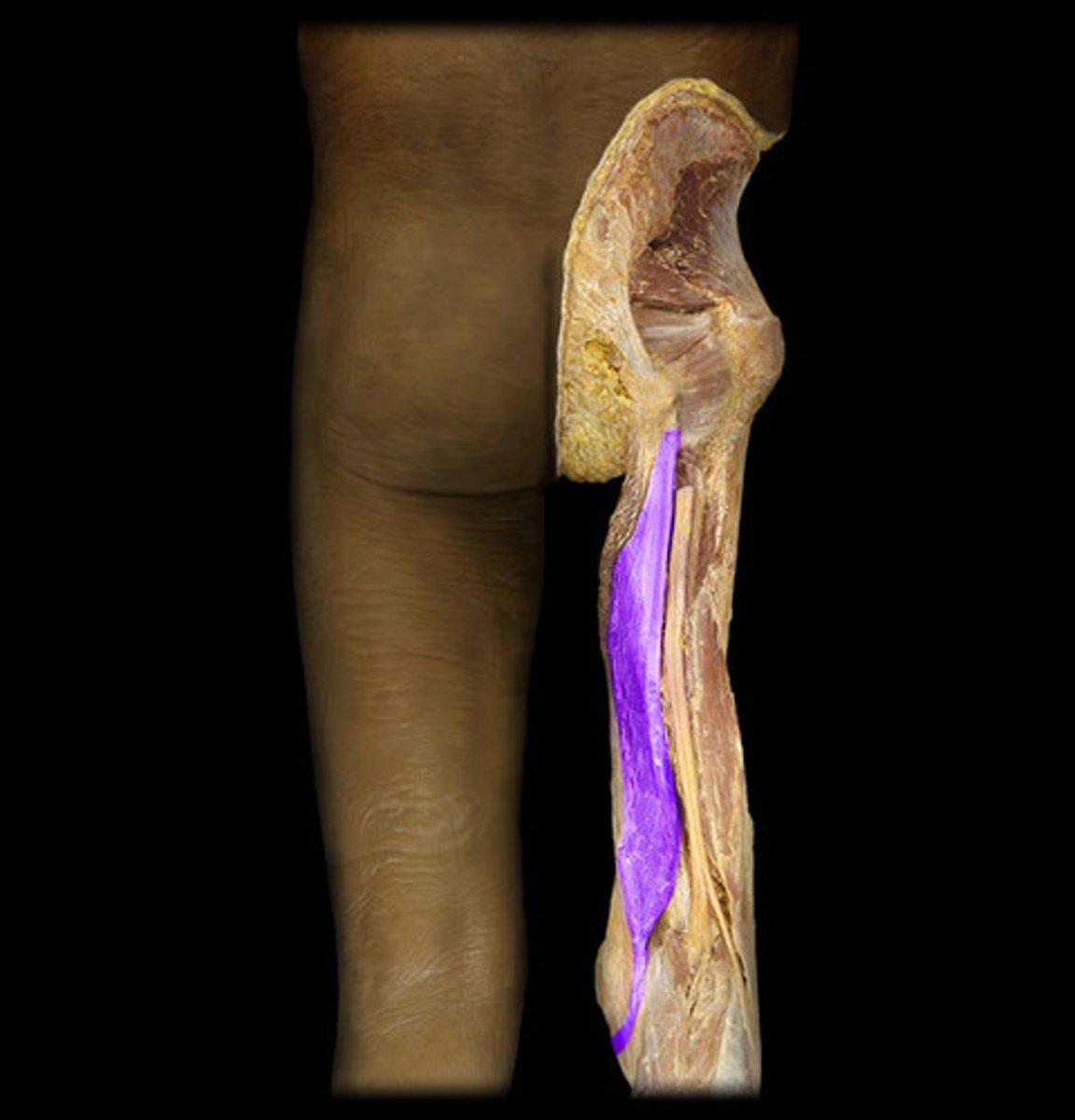
Semitendinosus
Origin: Ischial tuberosity
Insertion: Medial surface of upper tibia
Action: Flexes knee; medially rotates tibia on femur when tibia is fixed, medially rotates femur when hip is extended
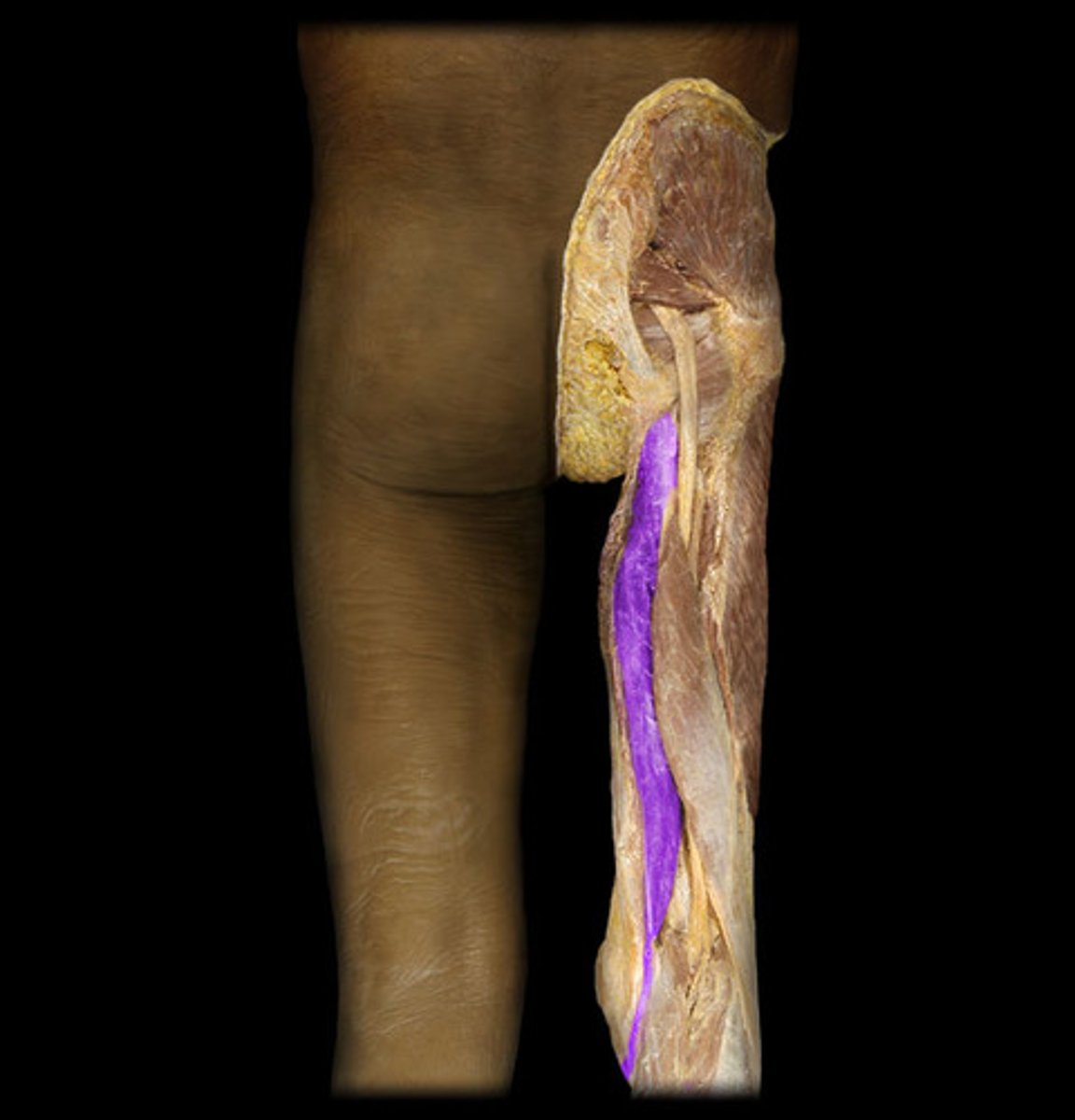
Vastus intermedius
Deep to rectus femoris
Origin: Anterior and lateral surfaces of femoral shaft
Insertion: Patella; tibial tuberosity; lateral and medial condyles of tibia
Action: Extends knee
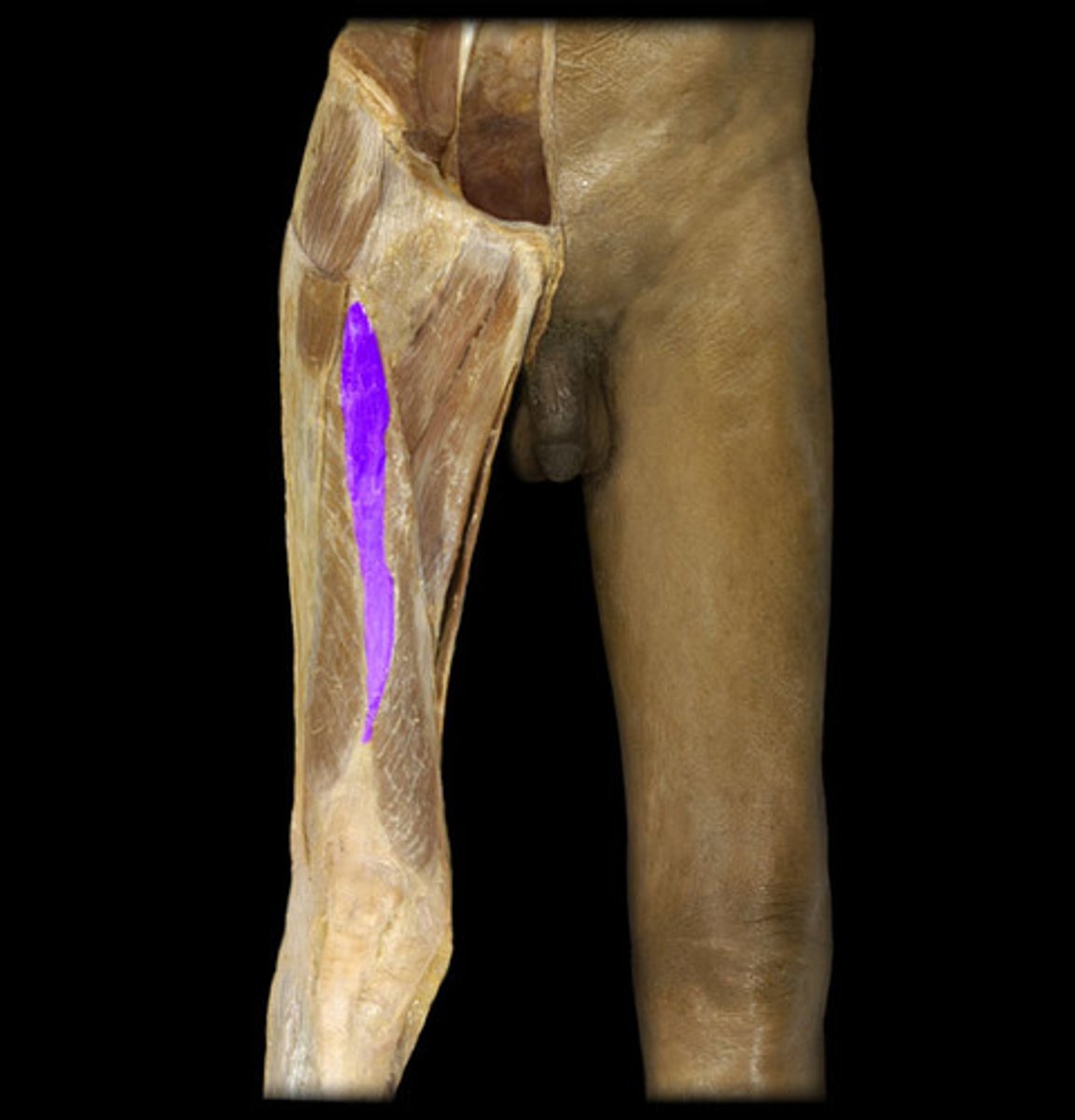
Vastus lateralis
Origin: Femur at greater trochanter and intertrochanteric line, gluteal tuberosity, and linea aspera
Insertion: Patella; tibial tuberosity; lateral and medial condyles of tibia
Action: Extends knee; aids in fixing patella during knee movements
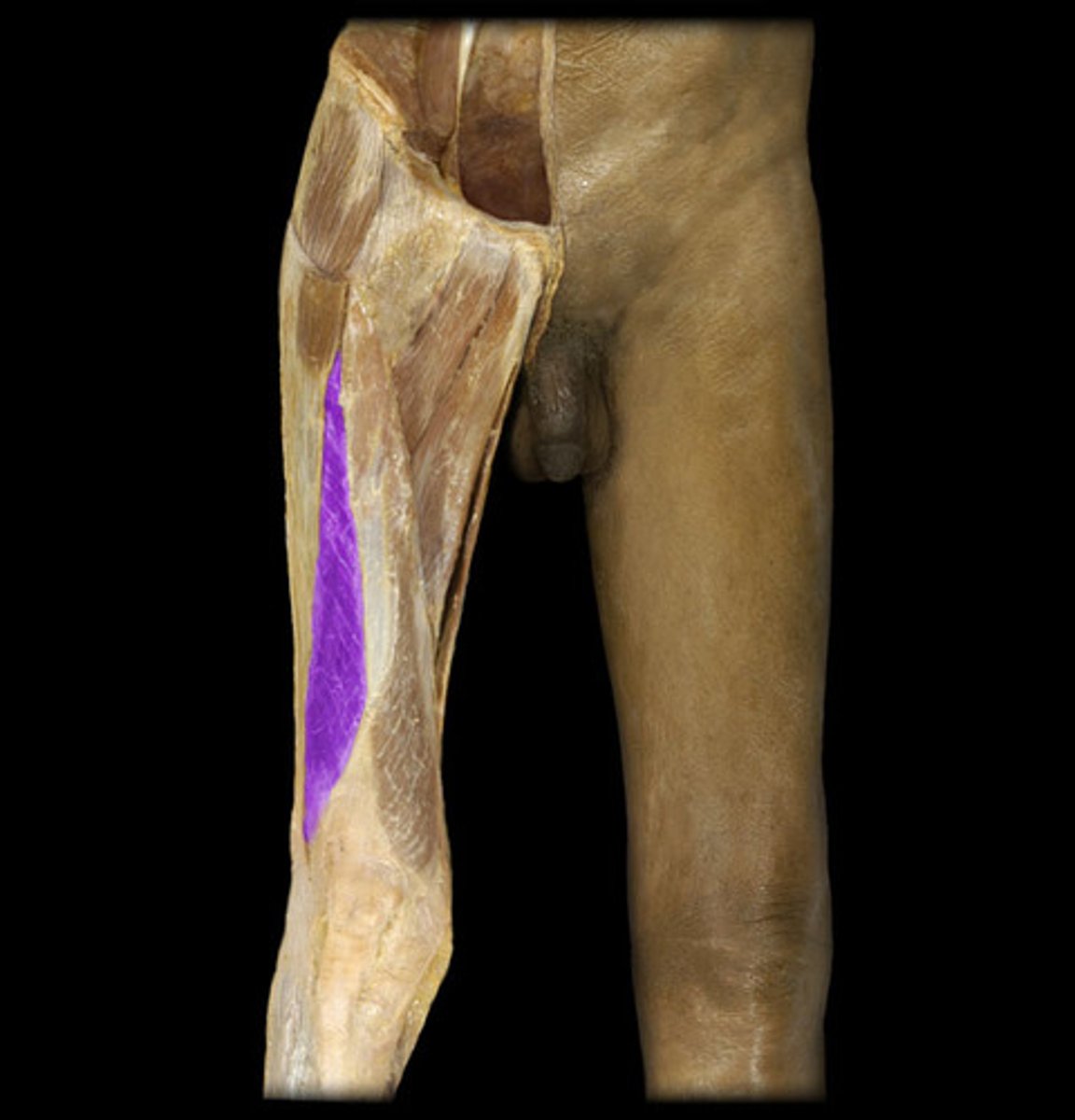
Vastus medialis
Origin: Femur at spiral line, linea aspera, and medial supracondylar line
Insertion: Patella; tibial tuberosity; lateral and medial condyles of tibia
Action: Extends knee; aids in fixing patella during knee movements

Gastrocnemius
Origin: Condyles, popliteal surface, and lateral supracondylar line of femur; capsule of knee joint
Insertion: Calcaneus
Action: Plantar flexes foot and flexes knee
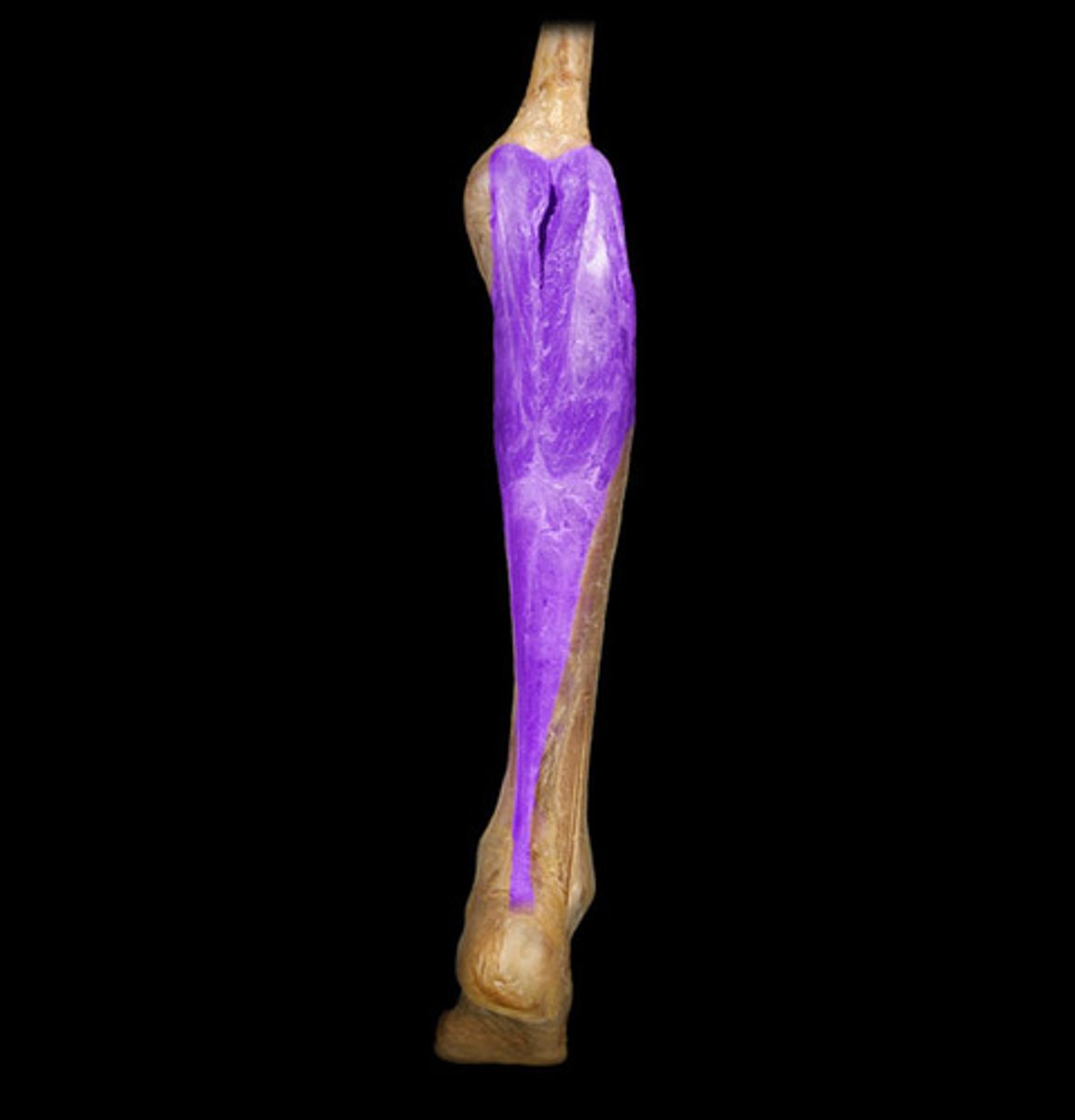
Soleus
Origin: Posterior surface of head of fibula and proximal one-fourth of tibia; interosseous membrane
Insertion: Calcaneus
Action: Plantar flexes foot; steadies leg on ankle during standing
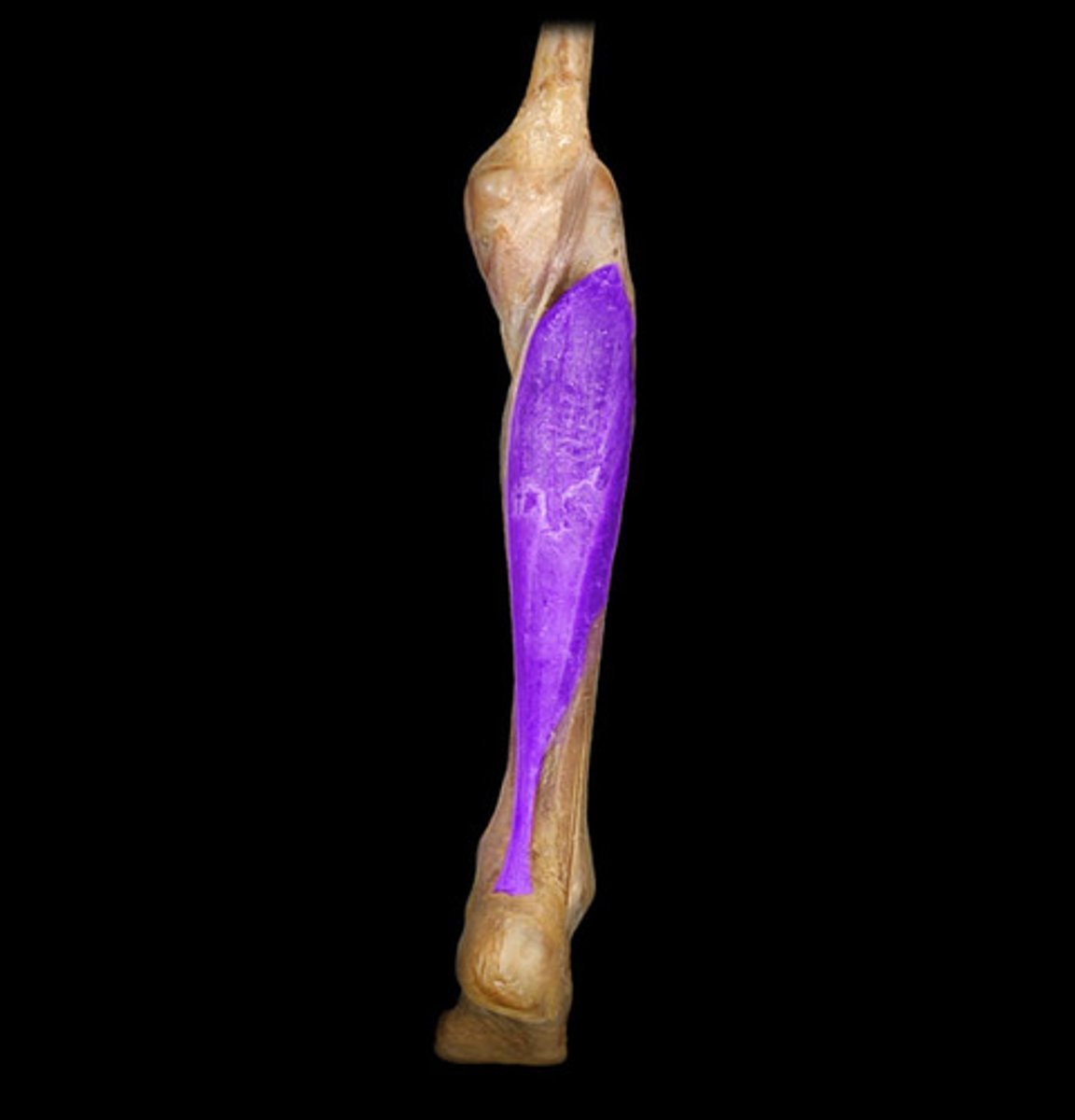
Temporalis
Origin: Temporal Lines and Temporal Fossa of Cranium
Action: Elevation of Mandible

Masseter
Origin: Zygomatic Arch
Action: elevates mandible

Obicularis Oculi
Origin: Lacrimal Bone, adjacent region of frontal bone and maxilla; medial angle of eyelids
Action: blinking, squinting, forceful closing of eyelids
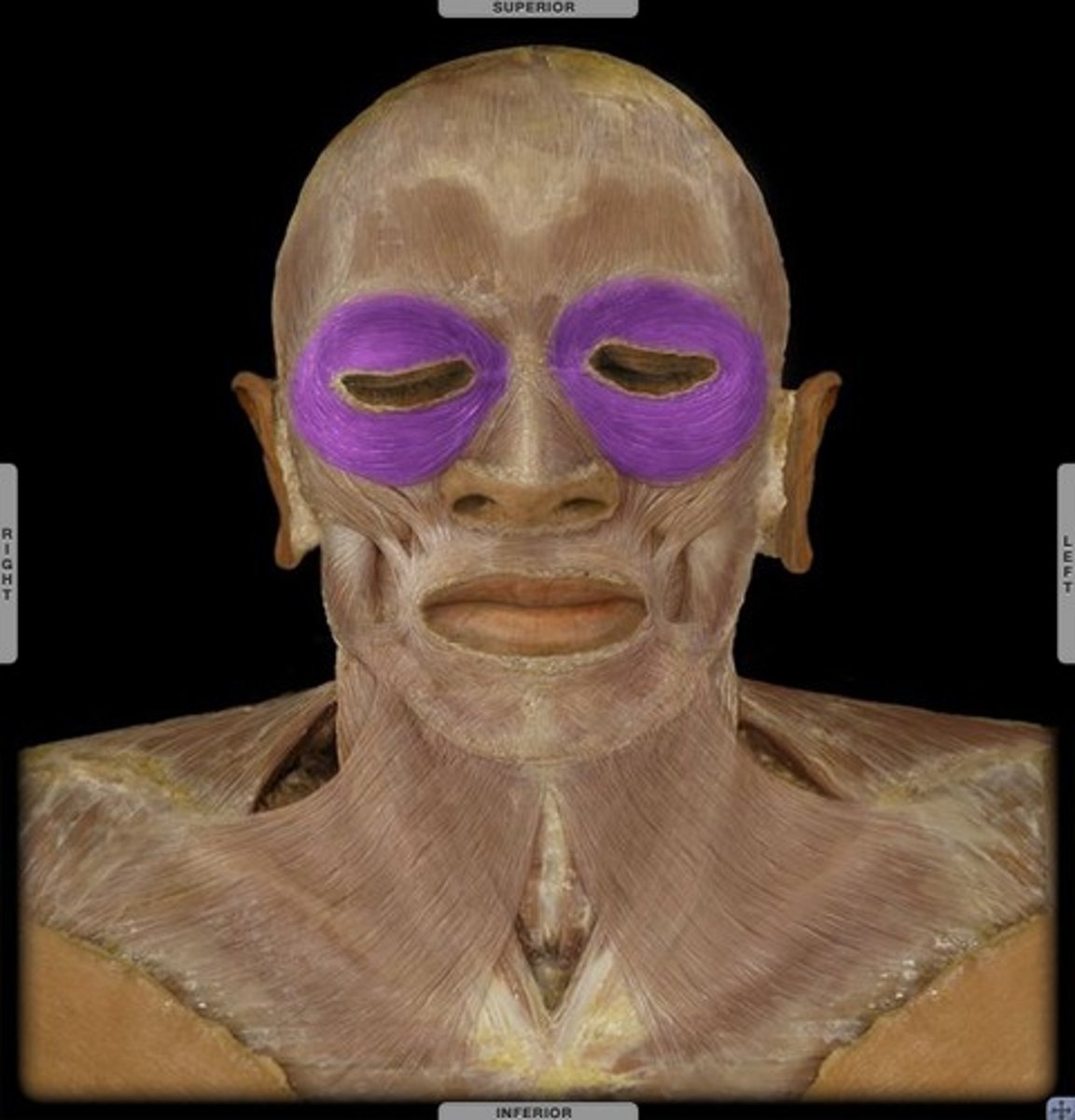
Levator Palpebrae Superioris
Origin: Lesser wing of sphenoid in posterior wall of orbit
Action: opens eyelid
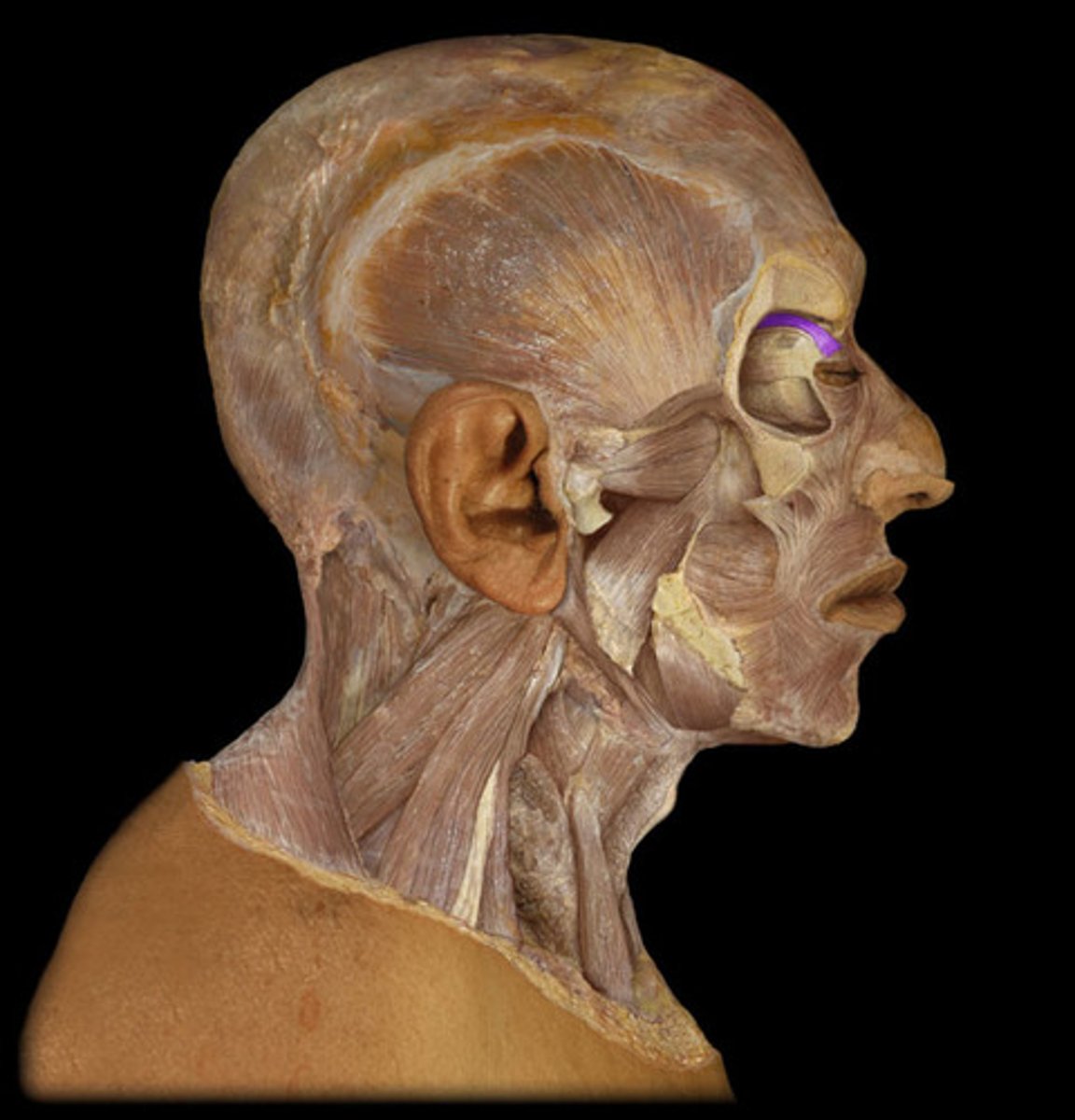
Obicularis Oris
Origin: Modiolus of mouth
Insertion: Submucosa and dermis of lips
Action: kissing, compresses lips against teeth, shapes lips in speech
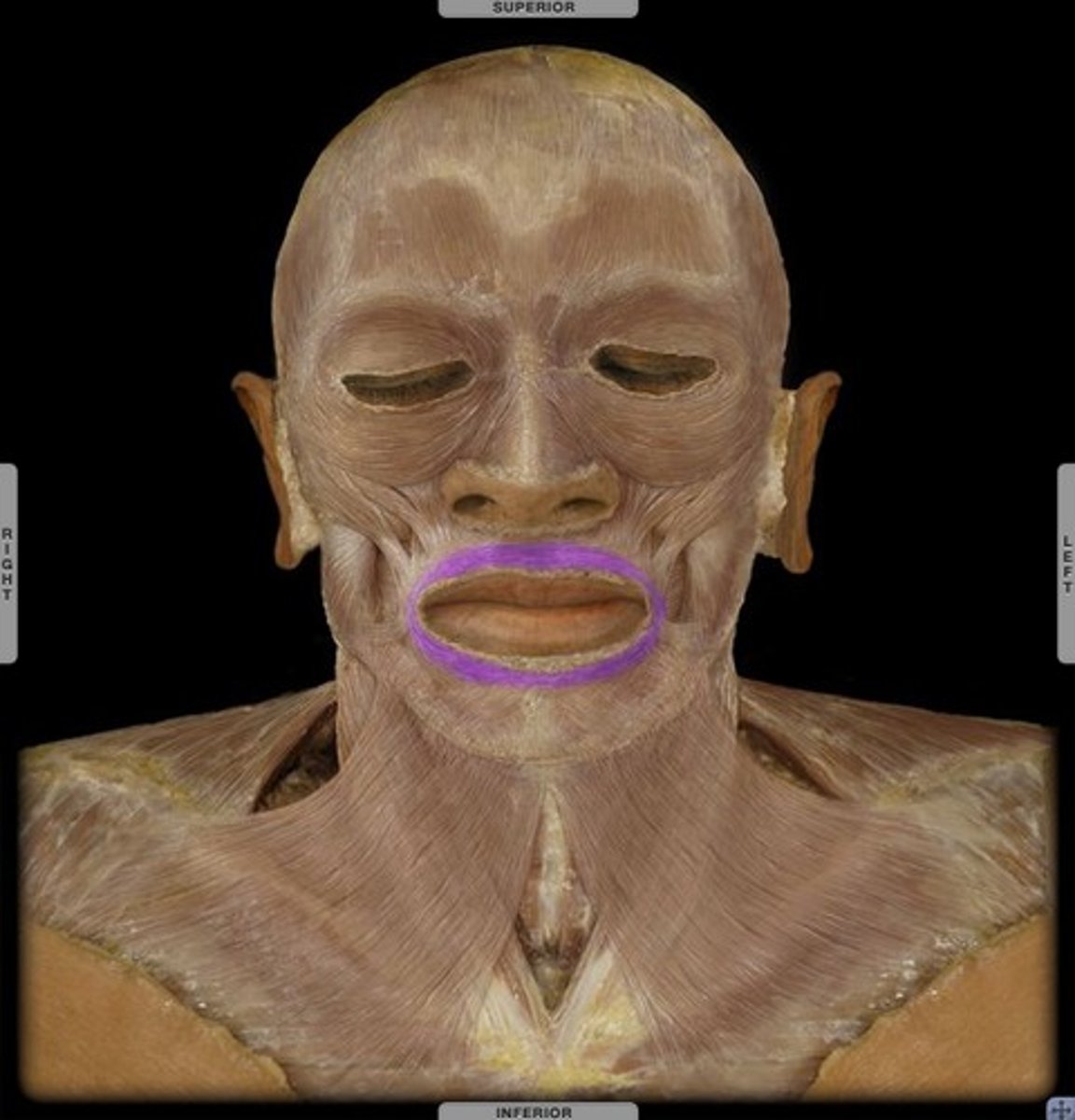
Platysma
Origin: Fascia of deltoid and pectoralis major
Insertion: Mandible, skin and subcutaenous tissue of lower face
Action: depresses mandible, draws angle of mouth downward (pout), tightens skin of the neck
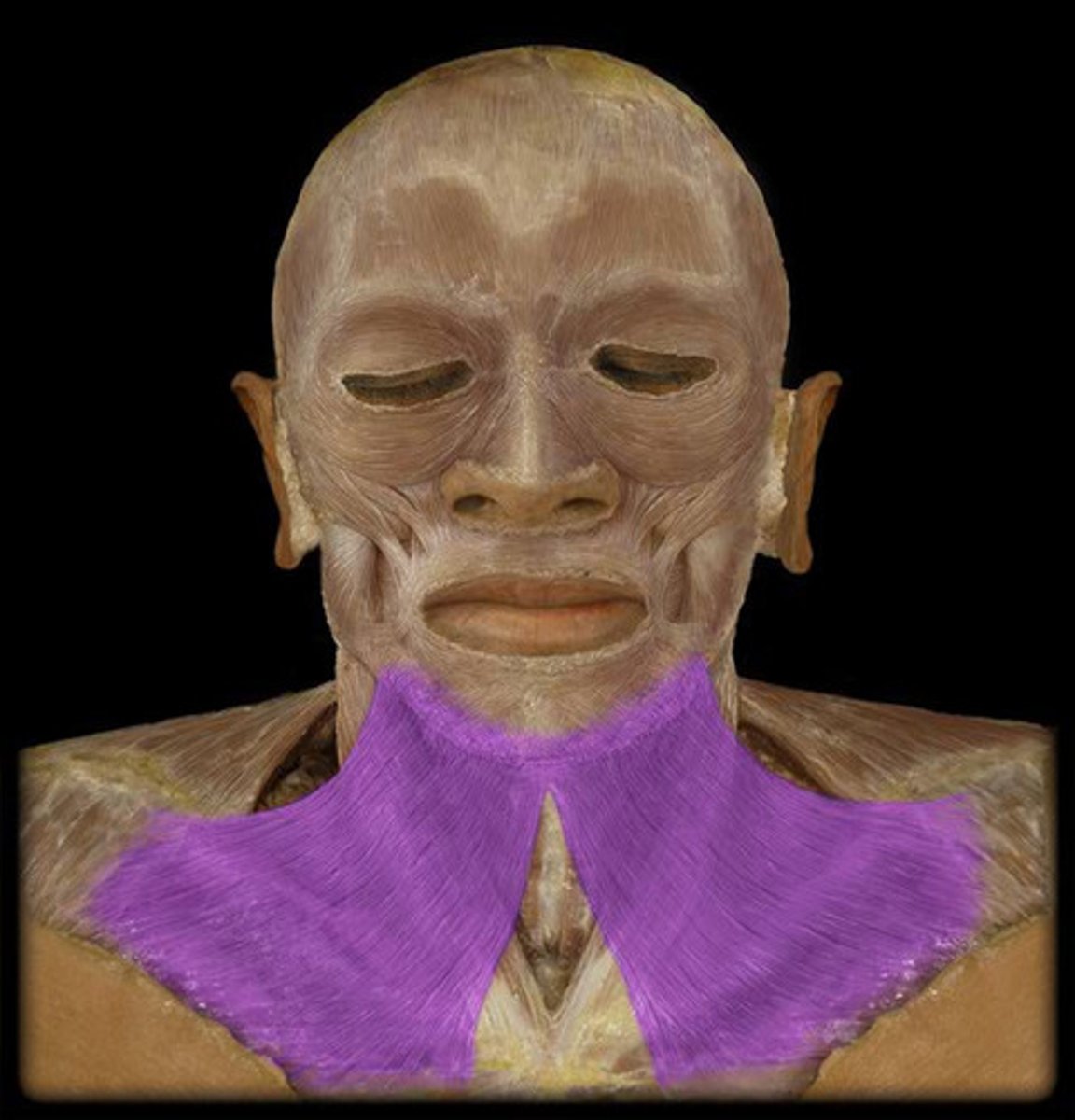
Sternocleidomastoid
Origin: Manubrium of sternum; medial 1/3 of clavicle
Insertion: Mastoid process of temporal bone
Action: head tilt, rotating head

Scalene
Origin: Transverse process of all cervical vertebrae
Insertion: Ribs 1-2
Action: helps breathe by elevating upper ribs, flexes head, rotates head side to side
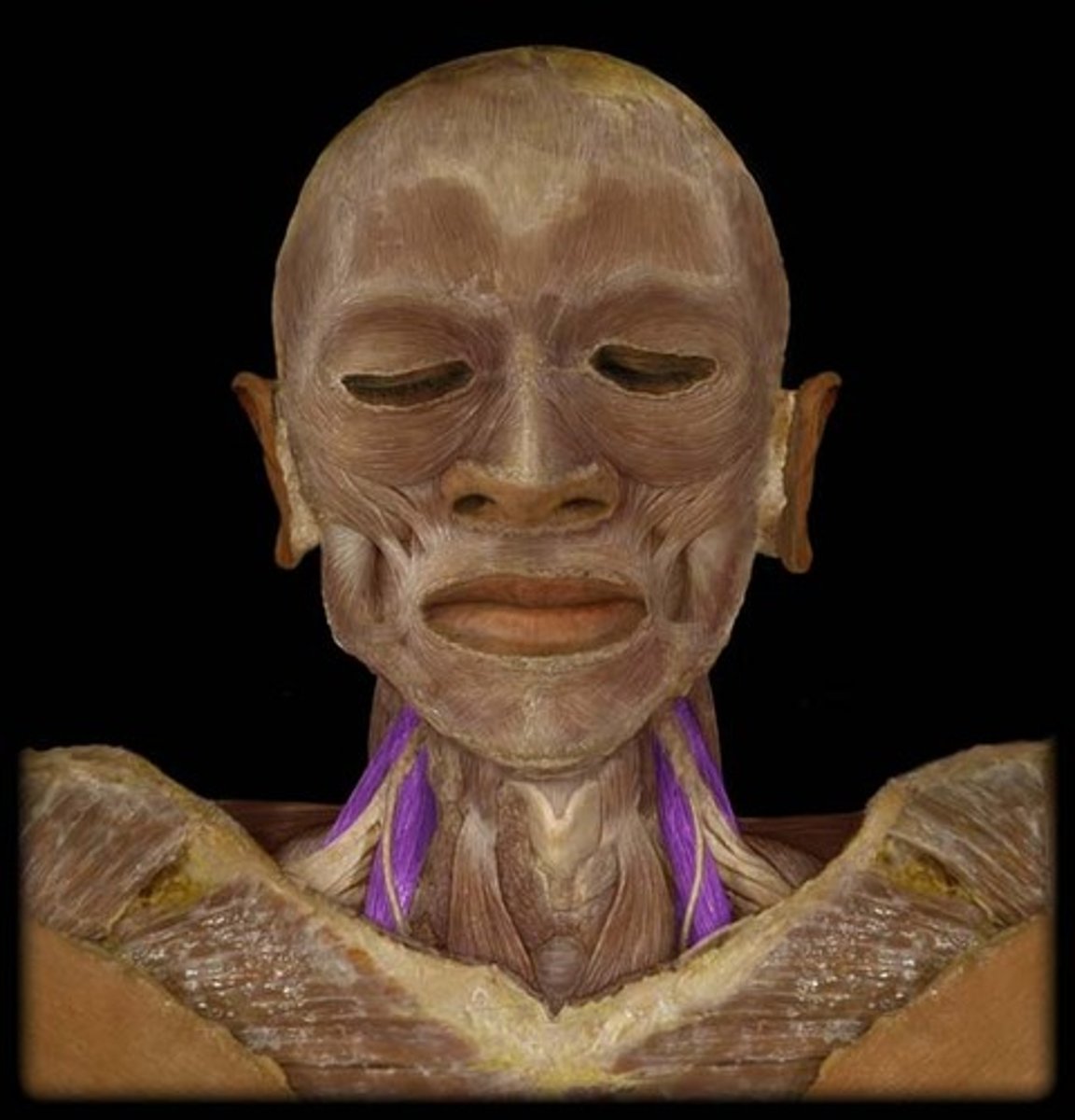
Digastric
Origin: Anterior Belly: Diagastric fossa of mandible: mastoid process of temporal bone
Insertion: Hyoid one via fascial sling
Action: depresses mandible, opens the mouth (when hyoid bone is fixed)
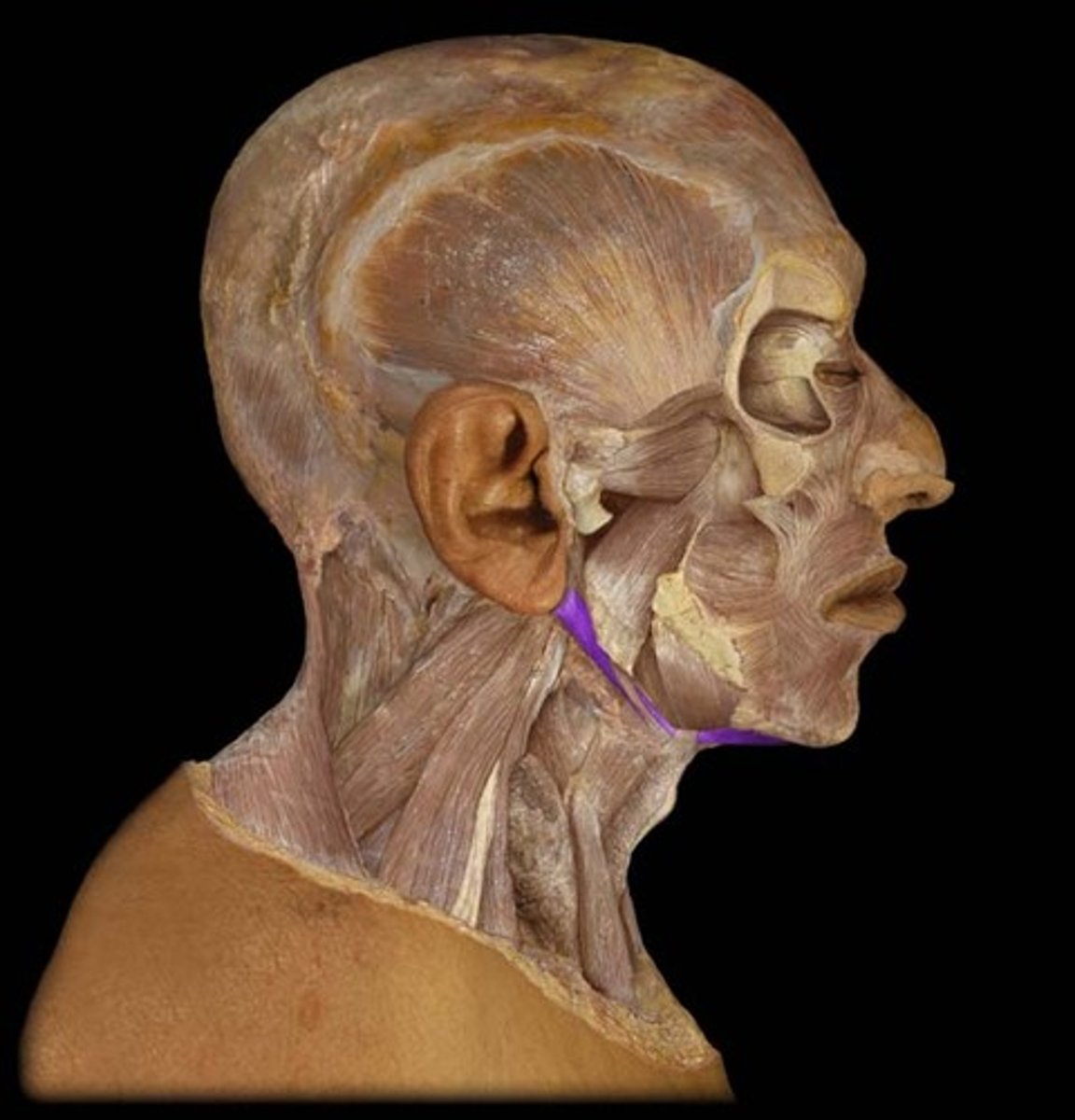
Stylohyoid
Action: elevates hyoid bone
Origin: styloid process of temporal bone
Insertion: hyoid bone
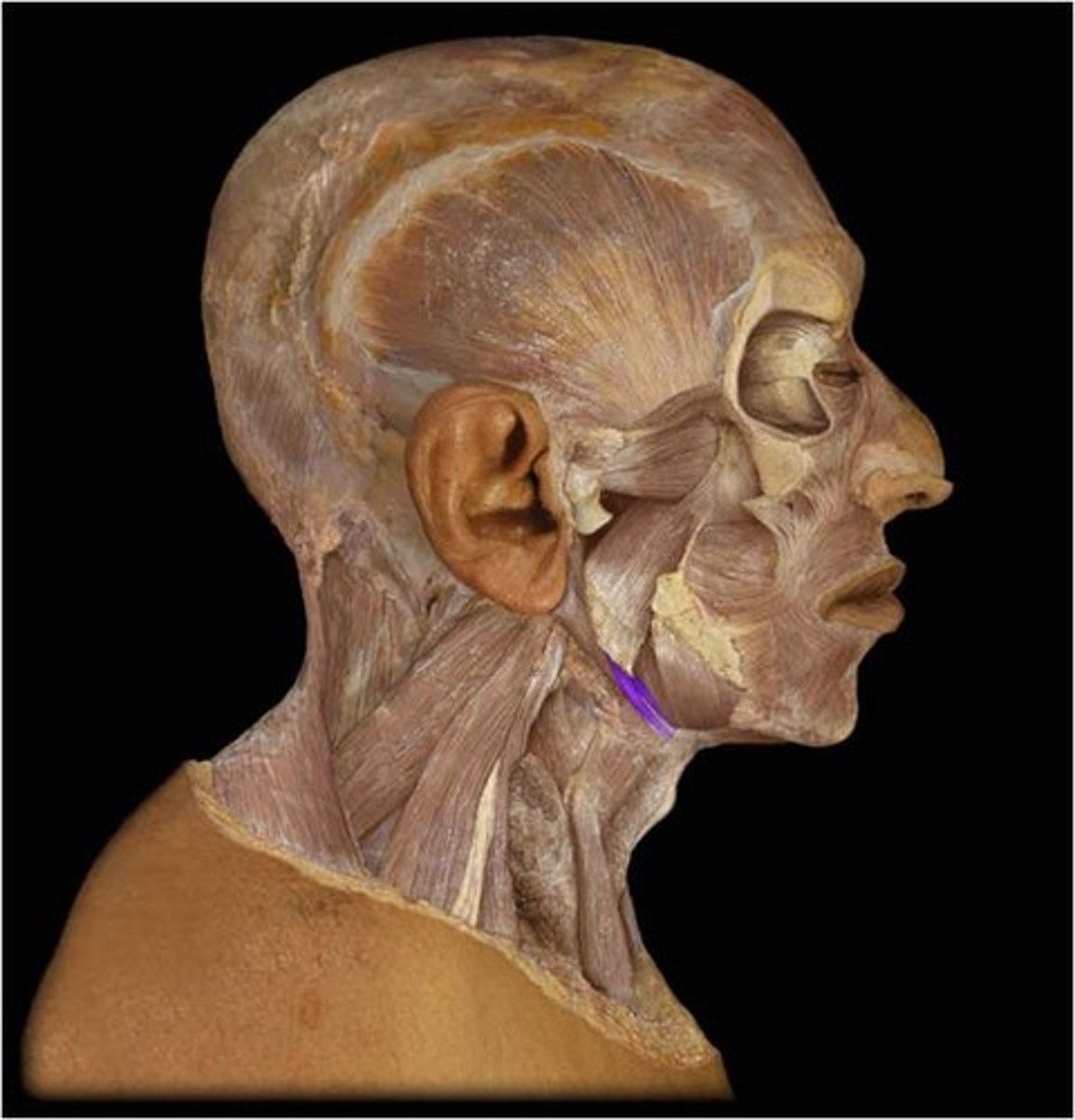
Sternothyroid
Origin: Manubrium of sternum; medial end of clavicle
Insertion: Thyroid cartilage of larynx
Action: Depresses larynx after it has been elevated in swallowing and vocalization
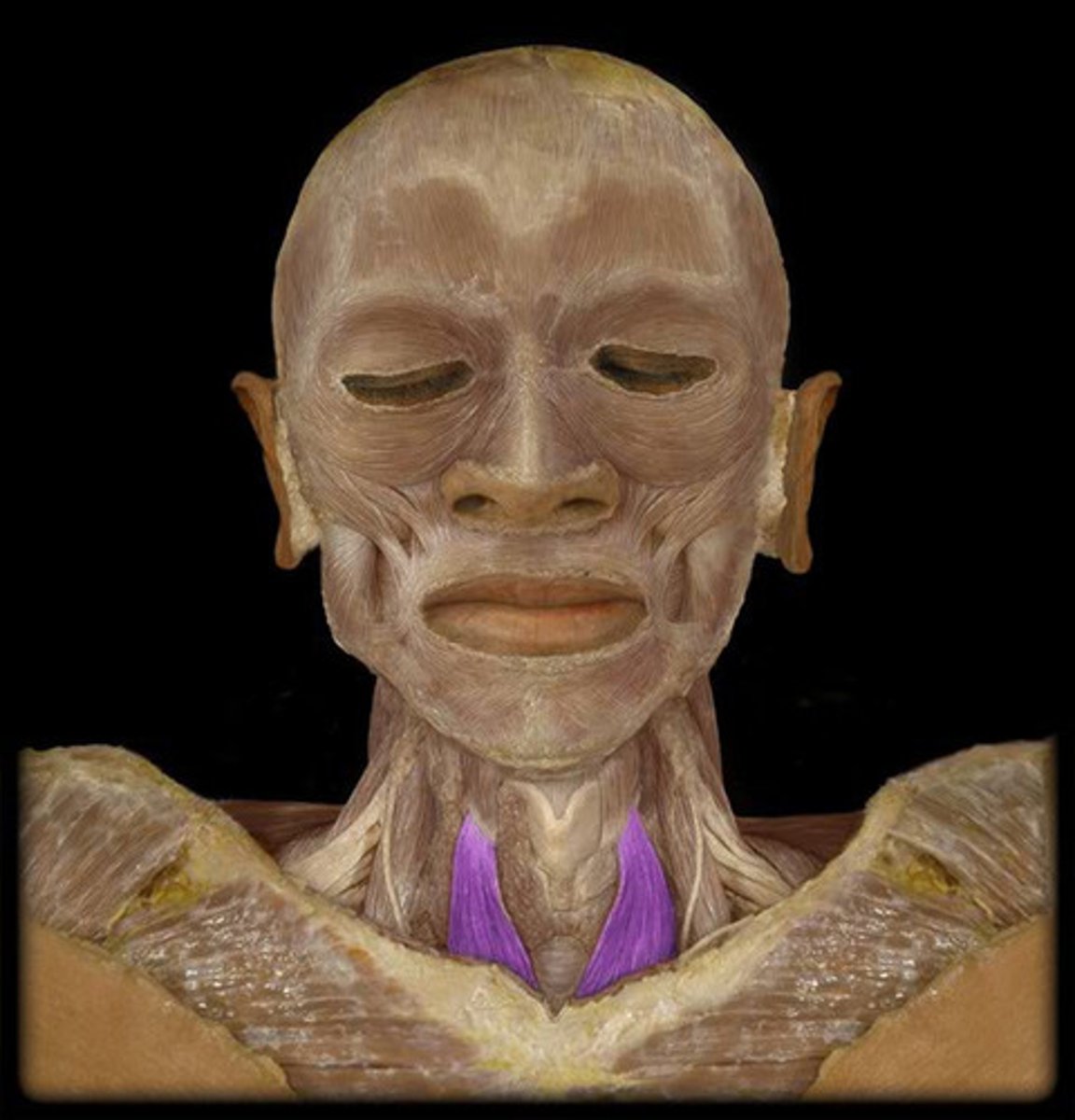
Omohyoid
Origin: Superior border of scapula
Insertion: Hyoid bone
Action: Depresses hyoid after being elevated
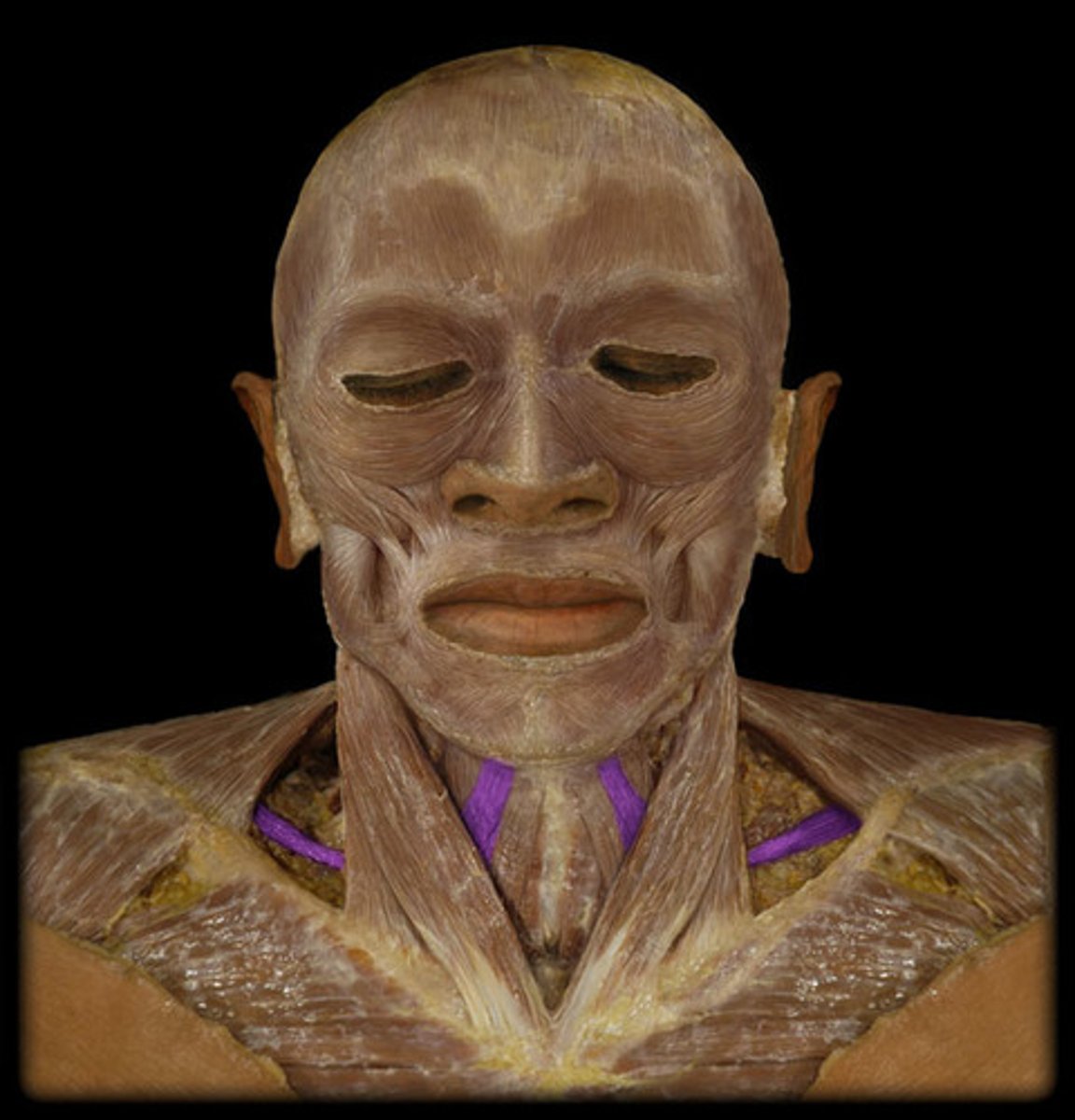
External intercostals
Origin: Inferior margins of ribs 1-11
Insertion: Superior margin of next lower rib
Action: when scalenes fix rib 1, external intercostals elevate and protract ribs 2-12, expanding the thoracic cavity and creating a partial vacuum causing inflow of air

Internal intercostals
Origin: Superior margins and costal cartilages of ribs 2-12; margin of sternum
Insertion: Inferior margin of next higher rib
Action: During inspiration, the intercartilaginous part aids in elevating the ribs and expanding the thoracic cavity. Expiration, incartilaginous part depresses and retracts the ribs and compresses the thoracic cavity expelling air
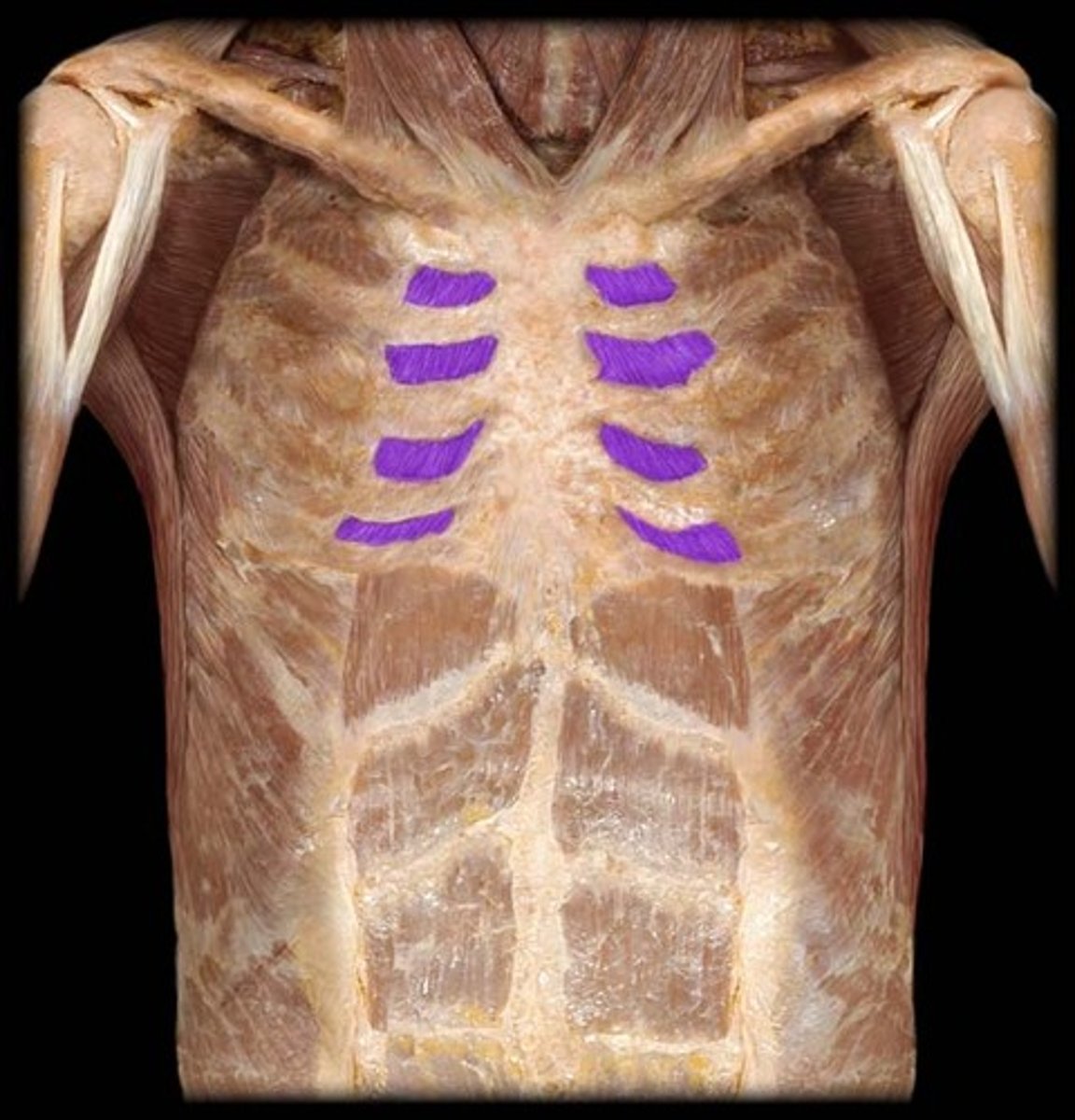
Rectus Abdominus
Origin: Pubic symphysis and superior margin of pubis
Insertion: Xiphoid process; costal cartilages 5-7
Action: flexes trunk, stabilizes pelvic region during walking, and compresses abdominal viscera
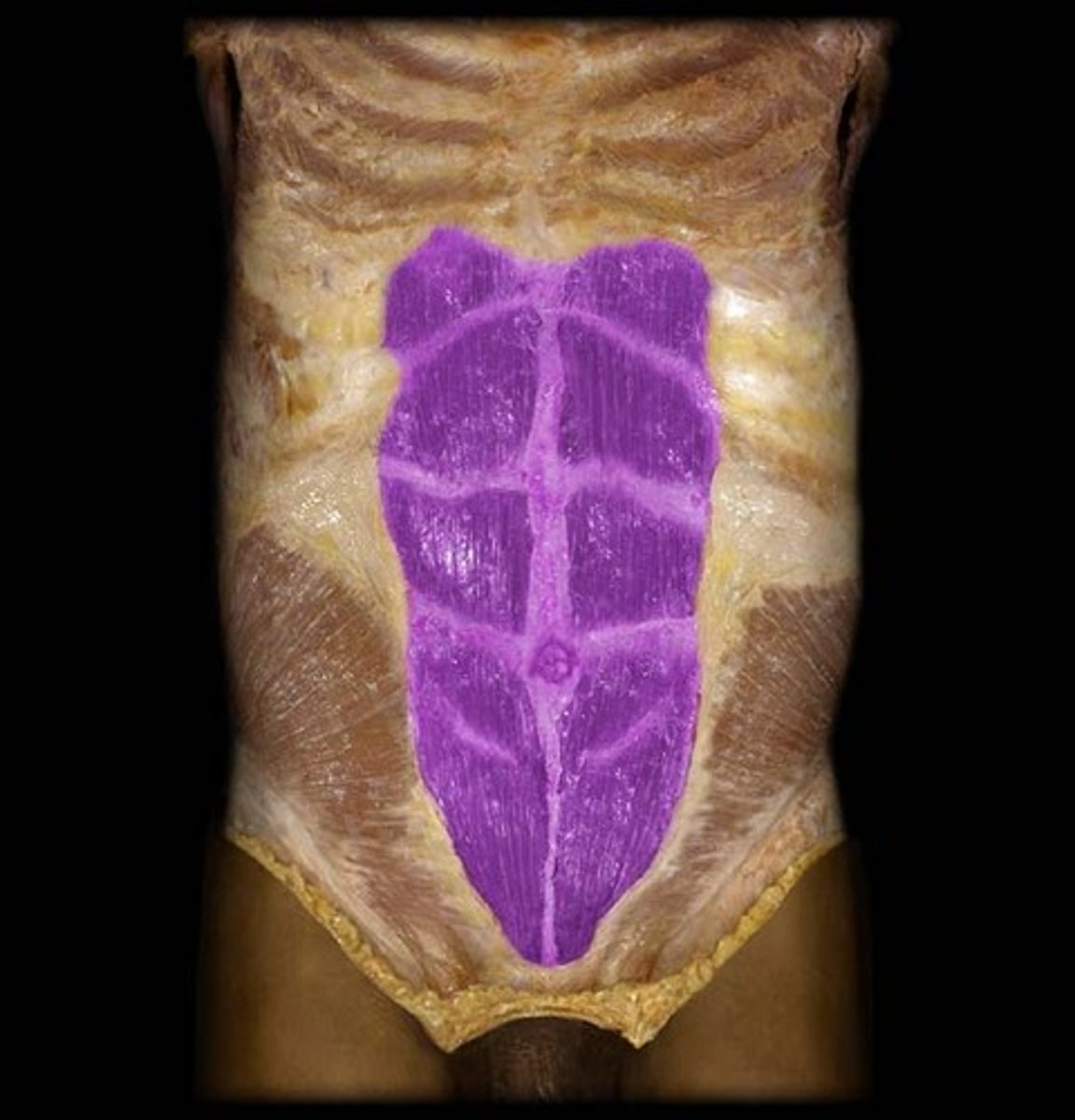
External Obliques
Origin: Ribs 5-12
Insertion: Anterior half of iliac crest; symphsis and superior margin of pubis
Action: supports viscera; stabilizes vertebral column; maintains posture
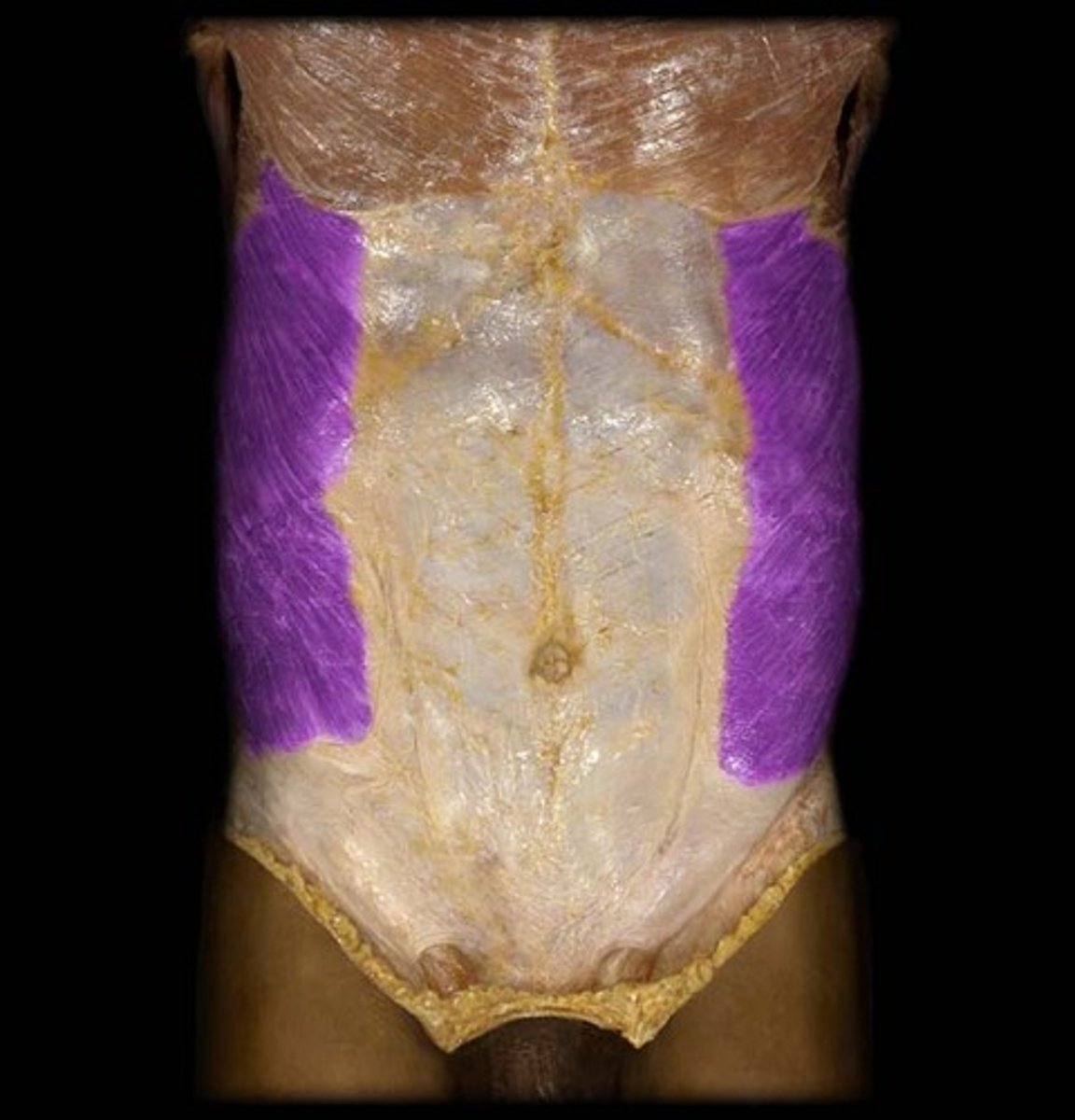
Internal Obliques
Origin: Inguinal ligaments; iliac crest; thoracolumbar fascia
Insertion: ribs 10-12; costal cartilages 7-10; pubis
Action: Support viscera' stabilizes vertebral column; maintains posture; unilateral contraction causes ipsilateral rotation of waist

Transverse Abdominus
Origin: Inguinal ligament; iliac crest; thoracolumbar fascia; costal cartilages 7-12
Insertion: Linea alba; pubis; aponeurosis of internal oblique
Action: Compresses abdominal contents; does not contribute to vertebral column movements

Linea Alba
Non-muscular, fiberous structure running between xiphoid process and pubic symphysis
Insertion: site for transverse abdominis
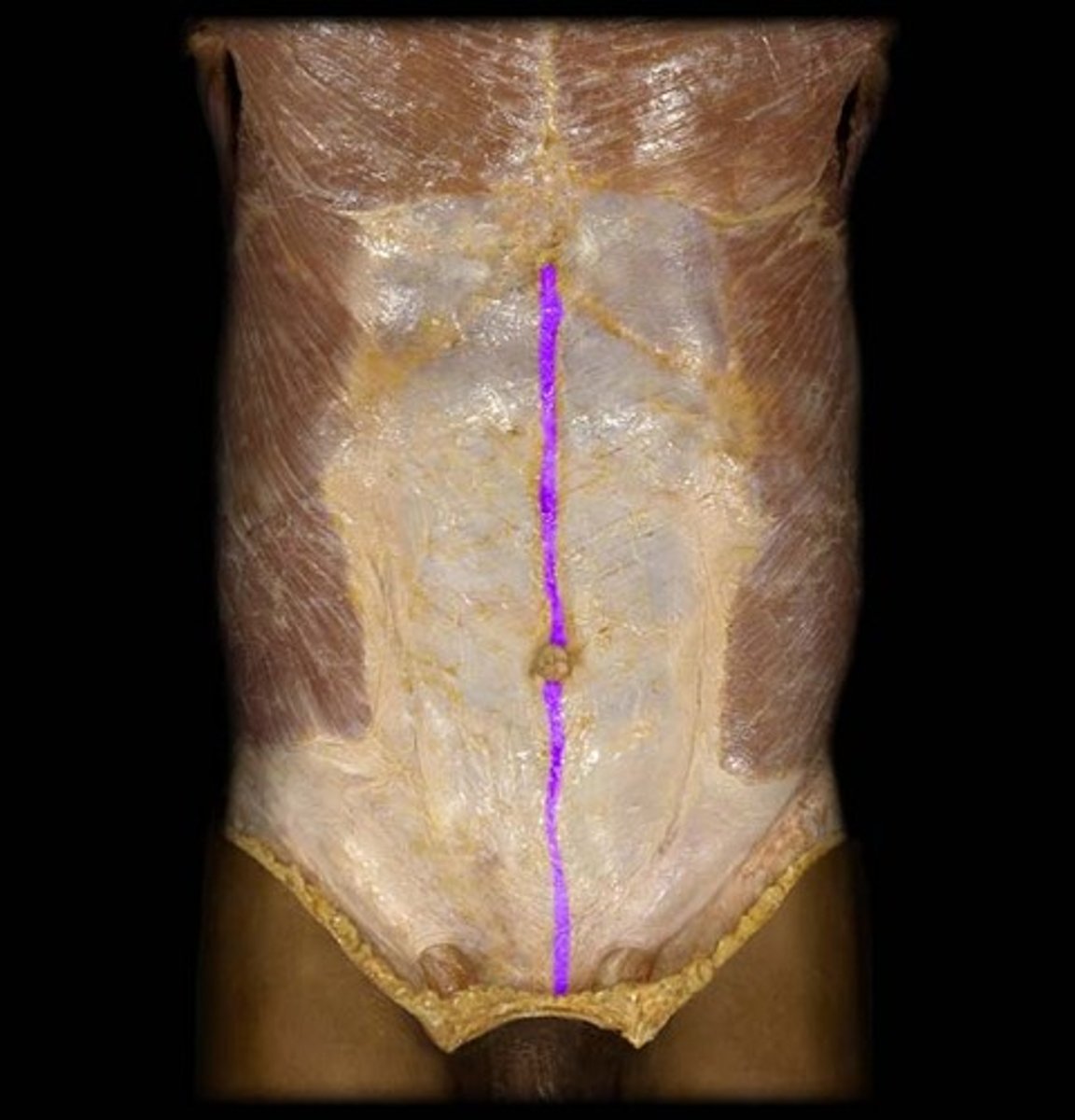
Iliocostalis
Origin: Dorsal sacrum; iliac crest; and spinous processes
Insertion: Ribs; transverse process of cerbical vertebrae
Action: Lateral flexion of vertebral column; extension of vertebral column; depression of ribs
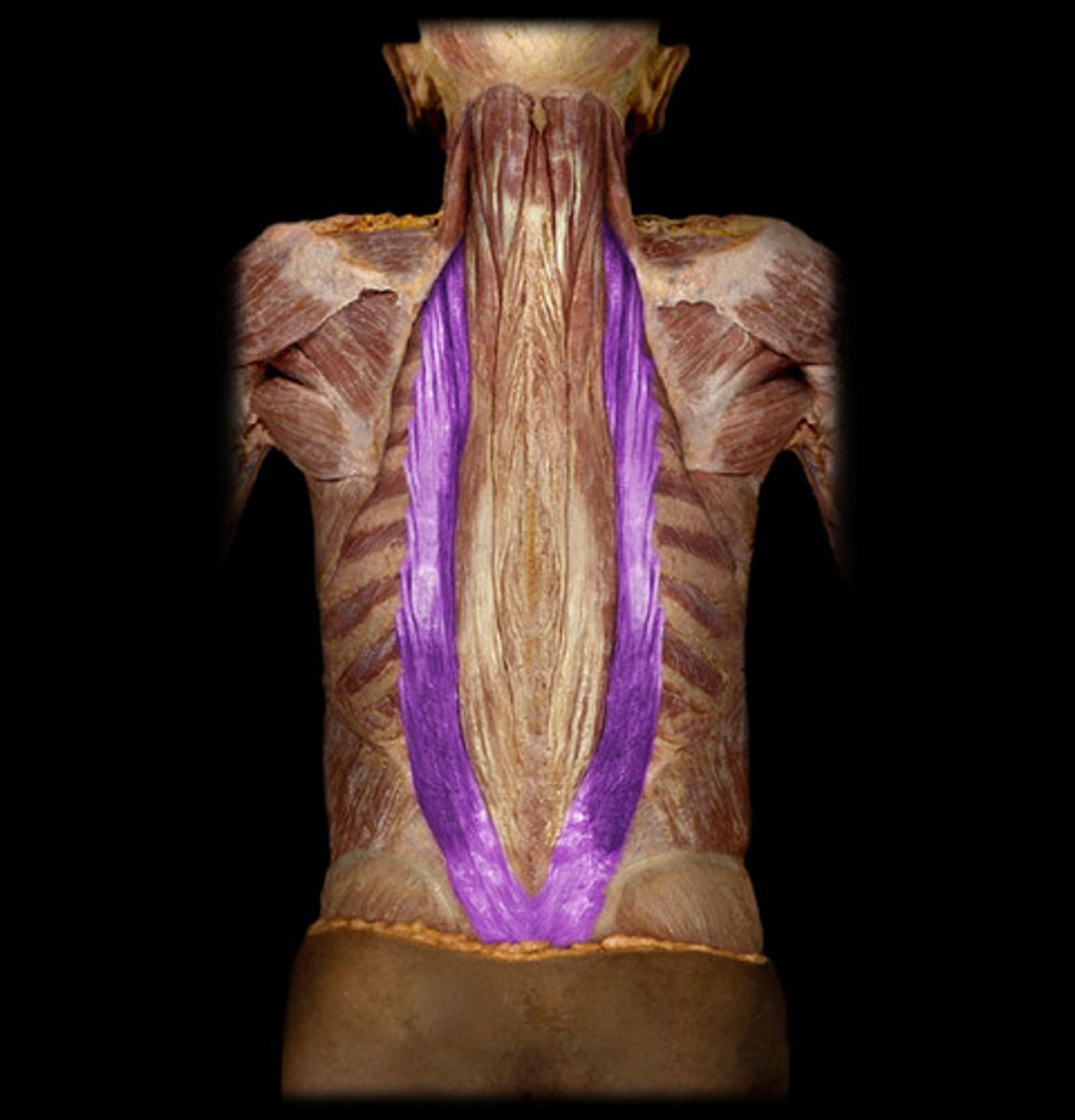
Longissimus
Origin: Dorsal sacrum; iliac crest; and spinous processes
Insertion: Transverse processes; ribs; and mastoid processes
Action: Unilateral- lateral flexion of vertebral column and rotation of head. Bilateral-extension of vertebral column and head. Depresses ribs

Spinalis
Origin: Spinous process and nuchal ligament
Insertion: Spinous processes and occipital bone
Action: Unilateral- lateral flexion of vertebral column. Bilateral-extension of vertebral column
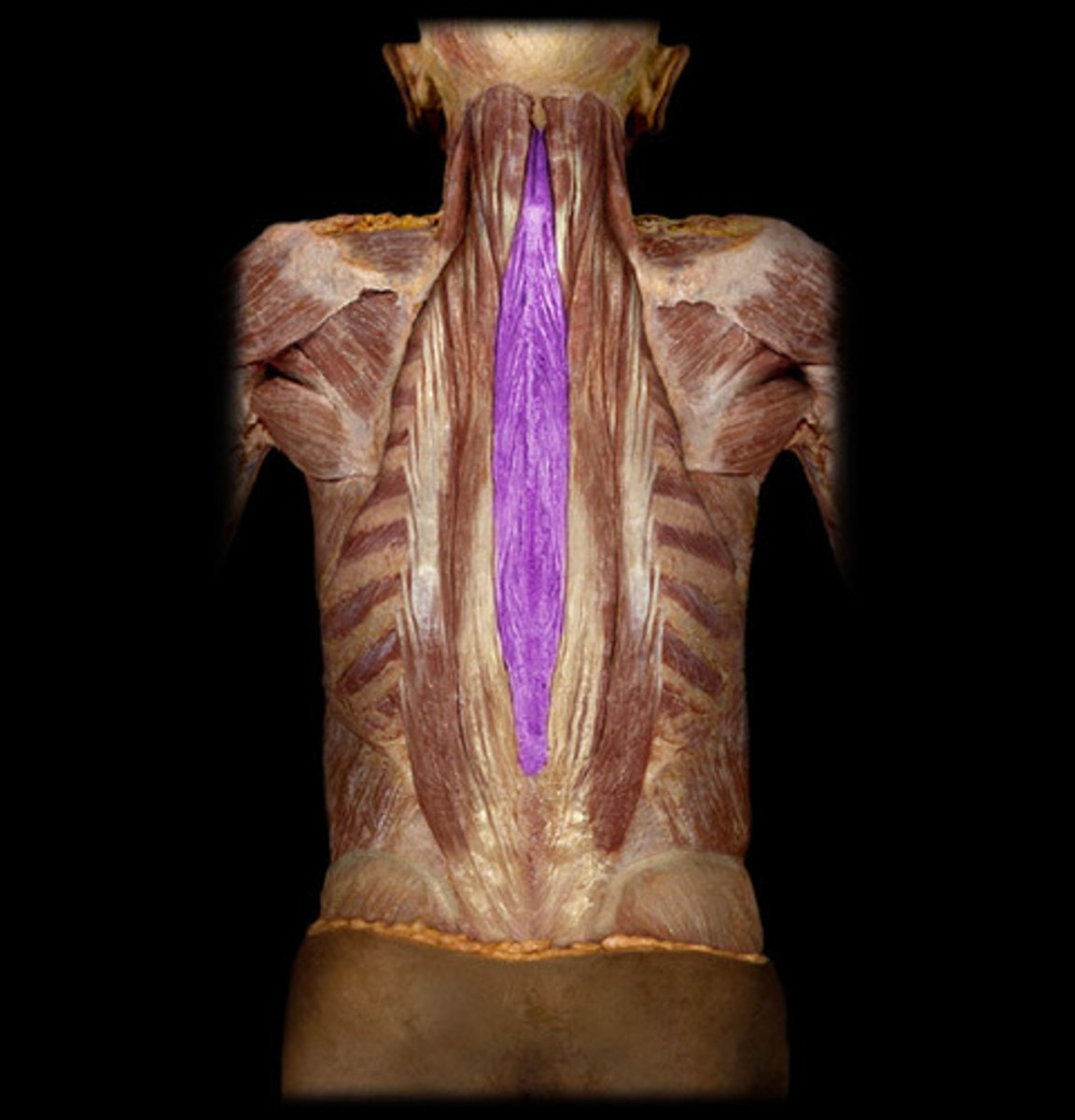
Diaphragm
Origin: xiphoid process of sternum, ribs and costal cartilages 7-12; lumbar vertebrae
Insertion: central tendon of diaphragm
Action: prime mover of inspiration; contraction compresses abdominal viscera and aids in childbirth and expulsion of urine and feces
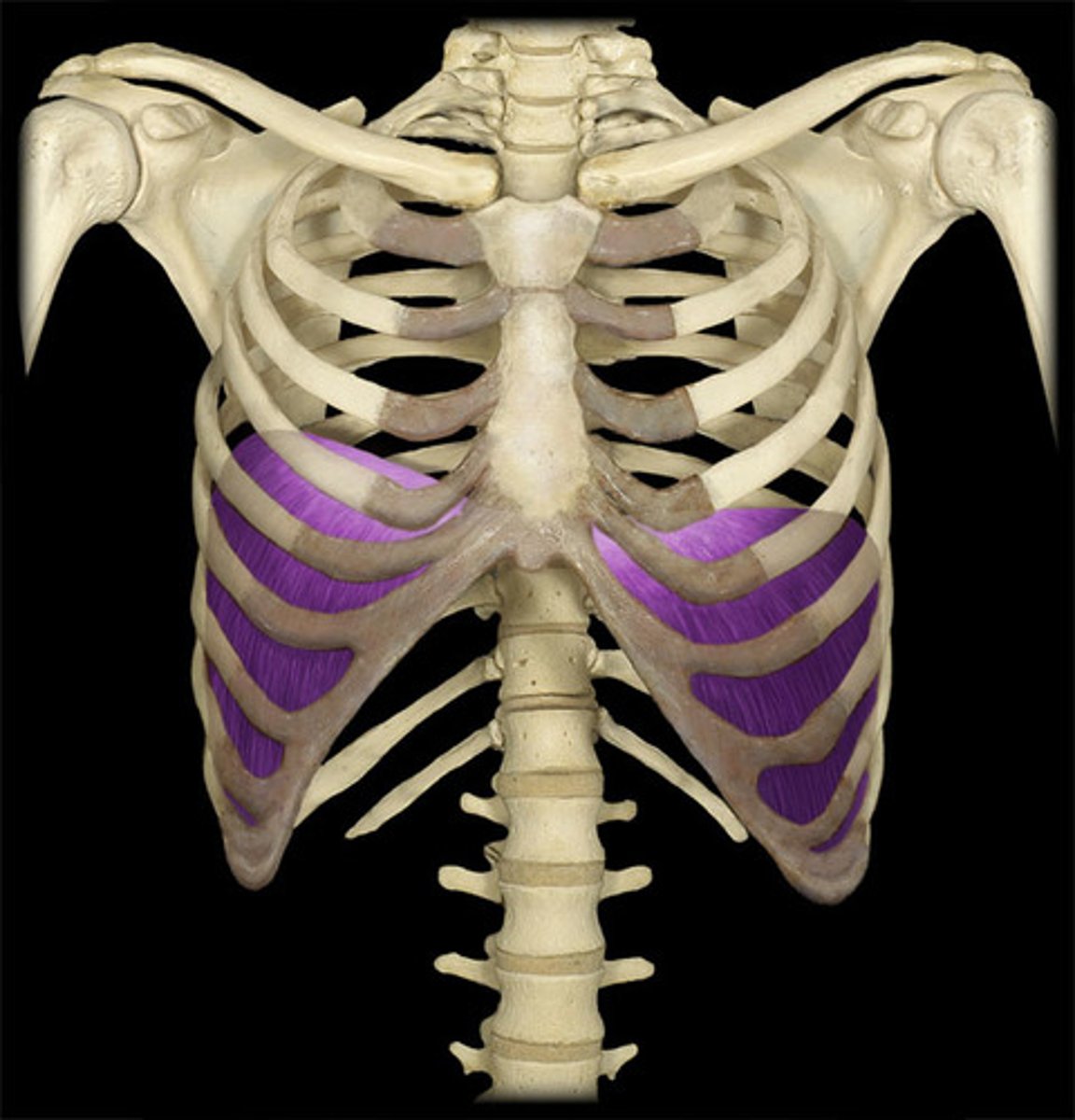
Myohyoid
Origin: inferior margin of mandible
Insertion: Hyoid bone
Action: Spans mandible from side to side and forms floor of mouth; elevates floor of mouth in initial stage of swallowing
Mylohyoid
Thyrohyoid
Origin: Thyroid cartilage of larynx
Insertion: Hyoid bone
Action: Depresses hyoid
